What Aspect Of Romantic Writing Did Realist Writers Disapprove Of?
This is "The Romantic Period", chapter 6 from the book British Literature Through History (v. 0.1). For details on it (including licensing), click here.
This book is licensed under a Creative Commons by-nc-sa 3.0 license. See the license for more details, but that basically means you can share this book as long as you credit the author (but see below), don't make money from it, and do make it available to everyone else under the same terms.
This content was accessible as of December 29, 2012, and it was downloaded then by Andy Schmitz in an effort to preserve the availability of this book.
Normally, the author and publisher would be credited here. However, the publisher has asked for the customary Creative Commons attribution to the original publisher, authors, title, and book URI to be removed. Additionally, per the publisher's request, their name has been removed in some passages. More information is available on this project's attribution page.
For more information on the source of this book, or why it is available for free, please see the project's home page. You can browse or download additional books there. To download a .zip file containing this book to use offline, simply click here.
Has this book helped you? Consider passing it on:

Creative Commons supports free culture from music to education. Their licenses helped make this book available to you.

DonorsChoose.org helps people like you help teachers fund their classroom projects, from art supplies to books to calculators.
Chapter 6 The Romantic Period
PLEASE NOTE: This book is currently in draft form; material is not final.
6.1 The Romantic Period (1798–1832)
PLEASE NOTE: This book is currently in draft form; material is not final.
Learning Objectives
- Trace the political and philosophical roots of Romanticism.
- Compare and contrast neoclassicism and Romanticism.
- List and define characteristics of Romanticism.
- Explain the significance of Wordsworth's and Coleridge's 1798 Lyrical Ballads, and outline the major tenets of Wordsworth's 1802 Preface to Lyrical Ballads.
- List, define, and give examples of typical forms of Romantic literature.
The Roots of Romanticism
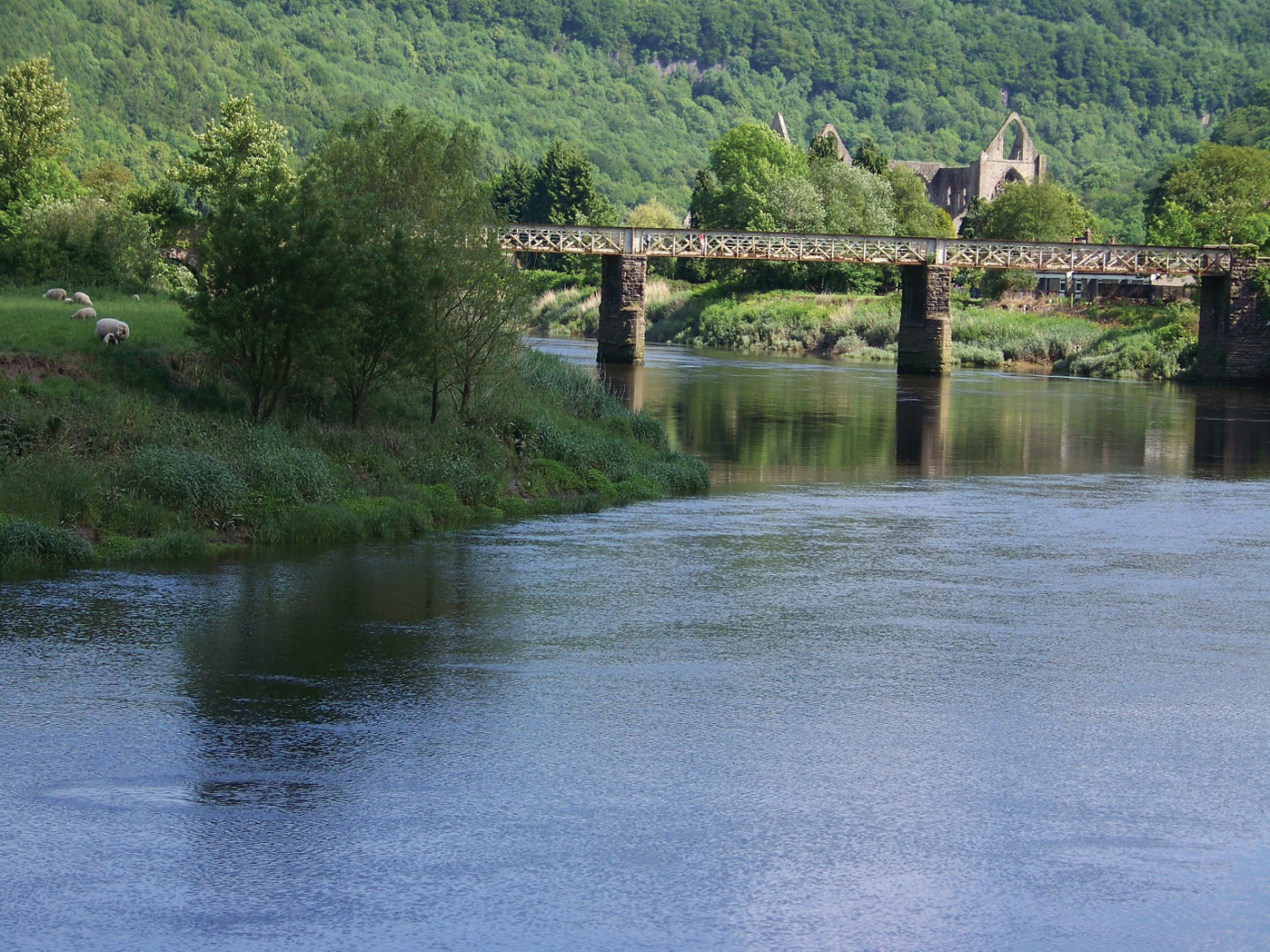
Tintern Abbey and the River Wye in Tintern, Wales.
Often the term Romantic literature, particularly poetry, evokes the connotation of nature poetry. Although nature is an important component in much Romantic literature, Romanticism is much more than recording the beauties of the natural world. And Romanticism is certainly not what modern readers usually think of when we hear the words romance and romantic; Romanticism does not refer to romantic love.
Romanticism grew from a profound change in the way people in the Western world perceived their place and purpose in life. Events such as the American Revolution in 1776, the French Revolution in 1789, and the Industrial Revolution restructured society and the way individuals viewed themselves and their relationship to each other and to the social order.
Democracy
In the late 18th and early 19th century, concepts such as the Great Chain of Being, which had long represented the way humans thought of themselves and their roles in society, crumbled in the wake of new ideas about democracy. Rather than placing themselves above or below other individuals in a hierarchy, people began to believe that all men are created equal. Although it took more time to be accepted, the idea that women and people of color are also created equal germinated in the fertile environment of democratic ideals.
Nature and Spirit
European philosophers such as Rousseau and Spinoza maintain that innocence and the potential for human goodness are found in nature; human institutions, such as governments, produce pride, greed, and inequality. Thus nature, and people close to nature, becomes the ideal for Romantic writers.
Nature takes on additional significance with the ideas of philosophers such as Schelling who posits an identity of mind and nature: "Nature is visible spirit.…" For poets such as Wordsworth and Coleridge, nature is a source of divine revelation, a visible veil through which God may be discerned. For others such as Shelley, nature is the means to tapping into the collective power of the human mind, what American writer Ralph Waldo Emerson refers to as the Over-Soul. Nature is the source of human innocence and goodness because nature is a manifestation of the Divine.
For Romantic writers, then, the source of poetry is not a conscious crafting of lines of a certain number of syllables in a certain metrical pattern and rhyme scheme, like the 18th-century heroic couplet. Instead, the source of literature is the inspiration that comes from connecting, through nature, with the divine or the transcendental properties of the human mind. Romantic writers use the term Imagination to refer to this connection. The power of God to create nature is parallel to the poet's power to create through the Imagination. In his A Defence of Poetry, Percy Bysshe Shelley states that the Imagination "strips the veil of familiarity from the world, and lays bare the naked and sleeping beauty, which is the spirit of its forms." In his "Lines Composed a Few Miles Above Tintern Abbey," Wordsworth writes of "A motion and a spirit, that impels / All thinking things…" that he finds in nature. In his "The Eolian Harp," Coleridge pictures all of nature, including humans, as harps creating music when touched by the breeze of Imagination, the "One life" that is "in us and abroad."
Sturm und Drang
One facet of Romanticism also recognizes the dark side of the human mind. Originating in Germany, the Sturm und Drang (usually translated "storm and stress") movement pictures an anti-hero, a character dark in appearance, mood, and thought, in rebellion against the restrictions of society. Ann Radcliffe and others wrote Gothic novelsNovels that typically feature picturesque yet haunted medieval castles and ruins, supernatural elements, death, madness, and terror. that typically feature picturesque yet haunted medieval castles and ruins, supernatural elements, death, madness, and terror. Gothic elements appear in many Romantic works: Heathcliff and the ghost of Catherine in Emily Brontë's Wuthering Heights, the mad wife in Charlotte Brontë's Jane Eyre, Mary Shelley's Frankenstein. Jane Austen's Northanger Abbey delightfully parodies the Gothic novel. In poetry, Byron's narrative poems feature dark, brooding anti-heroes called Byronic heroes, a role Byron played himself in his personal life. The Tate Britain provides an online tour through a previous exhibit of paintings that illustrate Romantic Gothic art.
Romanticism and Neoclassicism
Romanticism is a reaction against many facets of Neoclassicism. The following chart lists contrasting views of Neoclassicism and Romanticism.
| Neoclassicism | Romanticism |
|---|---|
| use and imitation of literary traditions from ancient Greece and Rome | use and imitation of literary traditions from the Middle Ages (including the medieval romance) |
| beauty in structure and order | beauty in organic, natural forms |
| art from applying order to nature | art from inspiration |
| heroic couplets | lyric poetry |
| focus on external people and events | focus on self-expression of the artist |
| Great Chain of Being | democracy |
| reason | mysticism |
| Reason leads to spiritual revelation | Nature leads to spiritual revelation |
| urban (glorifies civilization and technological progress) | rural (sees the evils of civilization and technological progress) |
| values wit and sophistication | values primitive, simple people |
| Human nature needs artificial restraints of society | Restraints of society result in tyranny and oppression |
| the head | the heart |
Characteristics of Romantic Literature
- medievalism —Rather than looking for forms and subject matter from classical literature, Romantic-era writers prefer nostalgic views of the Middle Ages as a simple, less complicated time not troubled by the complexities and divisive issues of industrialization and urbanization. Often a Romantic medieval vision is not realistic, ignoring the violence and harshness of the Middle Ages with its religious persecution, political wars, poverty among the lower classes in favor of a fairy tale view of knights in shining armor rescuing beautiful damsels in distress. Or, from another perspective, the castles and mysterious aura of the so-called Dark Ages provide an ideal setting for Gothic literature.
- mysticismThe belief that the physical world of nature is a revelation of a spiritual or transcendental presence in the universe. —Romantic mysticism is the belief that the physical world of nature is a revelation of a spiritual or transcendental presence in the universe. Mysticism is not pantheism (worshipping nature). Romantic writers would worship not the tree, but the spiritual, sublime element manifested by the tree. Romantic literature, particularly poetry, is often characterized as nature poetry; mysticism explains the evident love of nature. Romantic writers love nature not only for its beauty but primarily because it is an expression of spirituality and the Imagination.
- sensibilityThe emotional enthusiasm that was a reaction, often an exaggerated reaction, to the reason and logic prized in neoclassicism. —When Jane Austen titled her novel Sense and Sensibility, she set up the dichotomy between rationalism and the emotional enthusiasm that was a reaction, often an exaggerated reaction, to the reason and logic prized in neoclassicism. In his Preface to Lyrical Ballads, Wordsworth defined poetry as the "spontaneous overflow of powerful feelings." The overwhelming emotional reaction to nature seen in Wordsworth's poetry, the emotional sensitivity to other individuals and their circumstances, particularly those from the lower socio-economic classes, and the supernatural evocation of terror in Gothic literature all are expressions of sensibility.
- primitivism and individualismInterest in the person who does not have the artificial manners of high society, the cultivated façade of the aristocracy. —Arising from two sources, philosophical theories that posit innocence is found in nature and the ideals of democracy, Romanticism values the primitive individual, the person who does not have the artificial manners of high society, the cultivated façade of the aristocracy. Individuals who are closer to nature are better able to recognize and exemplify goodness and spiritual discernment. Wordsworth espouses the common man and incidents from ordinary life as the appropriate subject for poetry. Romanticism places the individual in the center of life and experience.
Lyrical Ballads
Lyrical Ballads A collection of poems written and jointly published by William Wordsworth and Samuel Taylor Coleridge in 1798. is a collection of poems written and jointly published by William Wordsworth and Samuel Taylor Coleridge in 1798. The volume is of such importance that its 1798 publication date is often considered the beginning of the Romantic Period. The poetry in Lyrical Ballads marks a distinct change in both subject matter and style from the poetry of the 18th century.
William Wordsworth's Preface to Lyrical Ballads
In the 1802 edition of Lyrical Ballads Wordsworth includes a PrefaceAn introductory explanation. , an introductory explanation, to Lyrical Ballads to explain his theory of how poetry should be written.
The following points from the Preface delineate the characteristics that make these poems markedly different from poetry of the preceding century:
-
The language of poetry should be real language spoken by common people.
During the 18th century, many poets used what Wordsworth called "poetic diction," flowery or ornate words for ordinary things such as feathery flock instead of birds or finny tribe instead of fish. Wordsworth protests that people don't use such expressions; therefore poetry shouldn't either. Notice also that much of Wordsworth's poetry rejects the uniform stanzas and line lengths that were popular in the 18th century. Much of his poetry is free in form—lines and stanzas of varying lengths in the same poem, more like the "selection of language really used by men."
-
The subject of poetry should be events from the real lives of common people.
Wordsworth believes that common, ordinary situations are worthy topics for poems, events such as farmers plowing their fields. He further believes that through the Imagination he could make his audience more aware of the significance of common scenes that they might otherwise take for granted.
- "All good poetry is the spontaneous overflow of powerful feelings" and "takes its origin from emotion recollected in tranquility." Thus Wordsworth identifies sensibility rather than reason as the source of poetry.
- A poet is a "man speaking to men" but an individual who is extraordinarily perceptive. Wordsworth believes that the power of the Imagination enables poets to perceive the spiritual dimension found in the ordinary, in, as Coleridge says, all of animate nature. Sensibility allows the poet to understand and to convey the inner being of man and nature.
Forms of Literature
-
Novel
A novelAs famously defined in the Holman/Harmon Handbook to Literature, an "extended fictional prose narrative." , as famously defined in the Holman/Harmon Handbook to Literature, is an "extended fictional prose narrative." The novel flourished in the Romantic Period, encompassing novels previously listed by Anne Brontë, Charlotte Brontë, Emily Brontë, Mary Shelley, and Ann Radcliffe; Sir Walter Scott's historical novels, known as the Waverly Novels, set in medieval times and glorifying Scottish nationalism; and Jane Austen's novels of manners, portraying the genteel country life of the Regency era.
-
Lyric Poetry
A lyricA brief poem, expressing emotion, imagination, and meditative thought, usually stanzaic in form. is a brief poem, expressing emotion, imagination, and meditative thought, usually stanzaic in form.
-
Romantic Ode
As used in the Romantic Period, the odeA lyric poem longer than usual lyrics, often on a more serious topic, usually meditative and philosophic in tone and subject. is a lyric poem longer than usual lyrics, often on a more serious topic, usually meditative and philosophic in tone and subject.
-
Ballad
A balladA narrative poem or song, usually simple and regular in rhythm and rhyme. The typical ballad stanza is 4 lines rhyming abab. is a narrative poem or song. Ballads originated as songs that were part of an oral culture, usually simple and regular in rhythm and rhyme. The typical ballad stanza is 4 lines rhyming abab. Because of their simplicity and their role as part of folk culture, ballads were popular with many Romantic writers.
Key Takeaways
- Romanticism grew from a political and philosophical milieu which promoted democracy, equated nature and spirit, and valued sensibility over reason.
- Lyrical Ballads, published in 1798, is often considered the beginning of the Romantic period because Wordsworth's and Coleridge's poetry marks a distinct change in form and subject matter from neoclassical poetry.
- In his Preface to the 1802 edition of Lyrical Ballads, Wordsworth delineates the principles that define Romanticism and distinguish Romantic poetry from neoclassical poetry.
- Important forms of Romantic literature are the novel, lyric poetry, odes, and ballads.
Resources
Lyrical Ballads
- "Lyrical Ballads." Dove Cottage and the Wordsworth Museum. Wordsworth Trust.
Forms of Literature
- "Lyric." Literary Terms and Definitions. Dr. L. Kip Wheeler. Carson-Newman College.
- "Lyric." The UVic Writer's Guide. The Department of English. University of Victoria.
- "The Meditative Romantic Ode." Lilia Melani. English Department. Brooklyn College. City University of New York.
- "Novel." The UVic Writer's Guide. The Department of English. University of Victoria.
- "Ode." Literary Terms and Definitions. Dr. L. Kip Wheeler. Carson-Newman College.
- "Ode." The UVic Writer's Guide. The Department of English. University of Victoria.
6.2 Charlotte Turner Smith (1749–1806)
PLEASE NOTE: This book is currently in draft form; material is not final.
Learning Objectives
- Identify characteristics of Romanticism in Charlotte Turner Smith's work.
- Describe Smith's work as topographical poetry.
Biography
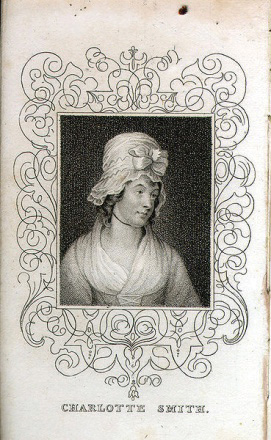
Portrait of Charlotte Turner Smith (1749–1806, frontispiece to an 1827 publication of her Elegiac Sonnets).
Early in her childhood, Charlotte Turner Smith lived in the Sussex downs that figure prominently in her writing. Years after the death of her mother, Smith's father remarried, promising his new wife that the teenaged Charlotte would not remain in the household. Her father arranged her marriage to a man who proved to be irresponsible, promiscuous, and abusive. While in debtor's prison with her husband and children, Smith earned enough money from her writing to obtain their release. After leaving her husband, she turned to writing in an attempt to support herself and their children.
Many of the hardships Smith faced in life—the death of her mother, her step-mother's dislike of her, the death of several of her children, her husband's abuse—found their way into her novels, poetry, and plays.
Video Clip 1
Charlotte Turner Smith
(click to see video)
View a video mini-lecture on Charlotte Turner Smith.
Romanticism
Now recognized as the first woman Romantic writer, perhaps even the first Romantic writer, Charlotte Smith's work was recognized by and an influence on Romantic poets such as Southey, Wordsworth, and Austen.
Her attention to nature and nature's association with the supernatural is one of the characteristics that her work shares with other Romantic writers.
Smith is also noted for her use of the sonnet and for initiating a new interest in the sonnet among later Romantic writers such as Wordsworth and Keats. The sonnet form, which had flourished during the Elizabethan Age, was little used during the Age of Enlightenment. Sonnet sequences such as Sidney's Astrophil and Stella emphasize the emotional ups and downs of a love affair. During the Age of Reason, such blatant sentimentalism was abandoned in favor of reason and rational thought, but with Romanticism came a new interest in literature of sensibility.
Texts
- "Beachy Head with Other Poems." British Women Romantic Poets, 1789–1832. An Electronic Collection of Texts from the University of California at Davis. Ophilia Yim.
- "Beachy Head: With Other Poems." Google Books.
- "Charlotte Turner Smith." The Works of Charlotte Smith—An Electronic Edition. Stephen C. Behrendt. Electronic Text Center, UNL Libraries. University of Nebraska, Lincoln.
- "Elegiac Sonnets." British Women Romantic Poets, 1789–1832. An Electronic Collection of Texts from the University of California at Davis. Charlotte Payne.
- "Elegiac Sonnets: by Charlotte Smith With Additional Sonnets and Other Poems." Google Books.
"Sonnet V. To the South Downs"
Ah, hills belov'd! where once, an happy child, Your beechen shades, "your turf, your flowers among," I wove your blue-bells into garlands wild, And woke your echoes with my artless song. Ah, hills belov'd! your turf, your flowers remain; But can they peace to this sad breast restore, For one poor moment soothe the sense of pain, And teach a breaking heart to throb no more? And you, Aruna! in the vale below, As to the sea your limpid waves you bear, Can you one kind Lethean cup bestow, To drink a long oblivion to my care? Ah, no!—when all, e'en hope's last ray is gone, There's no oblivion—but in death alone!
Like many of Smith's sonnets, "Sonnet V. To the South Downs" begins with a description of nature intricately tied to memories of her childhood, a pattern later found in much of William Wordsworth's poetry. The poem's content soon turns from natural description and the joy of childhood it elicits to the current sense of the speaker's pain. Lines 6–8 and lines 11 and 12 ask questions which serve as transition to the topic of the speaker's heartbreak, asking if even the current beauty and the remembrance of past joy can mitigate the speaker's emotional suffering in the present or the future. The couplet provides the answer: only death can provide the oblivion that will ease the speaker's pain.
Smith's volume of sonnets was first published in 1784. In the preface to the first edition, Smith notes that in these poems she records "melancholy moments" by "expressing in verse the sensations those moments brought," an explanation echoed in Wordsworth's "emotion recollected in tranquility."
"Sonnet XLIV. Written in the Church-yard at Middleton, in Sussex."
Press'd by the moon, mute arbitress of tides, While the loud equinox its power combines, The sea no more its swelling surge confines, But o'er the shrinking land sublimely rides. The wild blast, rising from the western cave, Drives the huge billows from their heaving bed; Tears from their grassy tombs the village dead, And breaks the silent sabbath of the grave! With shells and sea-weed mingled, on the shore, Lo! their bones whiten in the frequent wave; But vain to them the winds and waters rave; They hear the warring elements no more: While I am doom'd-by life's long storm opprest, To gaze with envy on their gloomy rest.
All along the southern coast of England, the chalk cliffs continuously erode into the sea. Famous for its South Down walks, the cliff area prominently displays frequent signs warning walkers not to approach the edges. Cliffs often collapse onto the beach far below, taking with them any objects or persons standing on the crumbling ground.
In the small village of Middleton-on-Sea, a church stood near the edge of the cliffs until centuries of erosion caused most of the building to tumble into the sea. As is common in English parish churches, the village graveyard surrounded the church building, allowing the dead to be buried in hallowed ground. During Smith's lifetime, an unusually high tide swept away part of the ruins of the church as well as land containing graves. Exposed bones were found on the beaches afterwards.
In Sonnet 44, the speaker again describes the physical scene, the focus on the bones left exposed on the shore by the destructive tide. As frequently occurs in these sonnets, the final couplet turns to the speaker's emotional state.
"Beachy Head"
The last poem written by Charlotte Smith, published posthumously, "Beachy Head" exemplifies many of the characteristics that have come to define Romantic poetry.
Perhaps most obvious is Smith's focus on the natural world. However, as is typical of Romanticism, nature is valued not just for its beauty but because of mysticism: the sense of a divine presence in nature. Note words with religious connotations in the poem.
The speaker's references to the hind (the rustic country-dweller) who makes an honest living and to the shepherd who is involved in smuggling both typify primitivism, the interest in the lower social classes, people who live close to nature.
Also, the poem reveals sensibility, the valuing of human emotion over reason.
At the same time, the poem exhibits traits of poetry from the Enlightenment. Note the personification of attributes such as Hope, Fancy, Luxury, and Memory.
Key Takeaways
- Charlotte Turner Smith is considered the first woman Romantic writer, perhaps even the first Romantic writer.
- Smith's work exemplifies characteristics of Romantic poetry such as mysticism, primitivism, and sensibility.
- Smith's work may be categorized as topographical poetry.
Exercises
- In Sonnet 44, the speaker describes the storm, the "wild blast," that tears the graves from the cliff. In the final couplet, what does the speaker compare to the storm?
- List some of the nature descriptions in both Sonnet 5 and Sonnet 44. How would you compare/contrast the details in the two poems.
- In Sonnet 44, how does the speaker compare herself to the dead on the beach?
- "Beachy Head" features many of the characteristics considered representative of Romantic poetry. Identify examples of these characteristics.
- List examples of Smith's identification of nature with supernatural or divine forces.
- In line 4 of "Beachy Head" and in other instances throughout the poem, the speaker refers to Fancy. Until Samuel Taylor Coleridge distinguished between fancy and imagination in his 1817 Biographia Literaria, the term fancy was considered to mean essentially the same creative function as imagination. Coleridge, however, defined fancy as a lower order skill: simply recalling events, reordering and arranging memories and impressions but not creating new meaning. Imagination he considered a much higher order skill involving creativity. Consider Smith's use of the term Fancy. Which definition do you think she intends?
- After describing the natural scene, Smith writes that natural objects are "the toys of Nature" that have little value "in Reason's eye." How does this comment relate to the 18th-century Enlightenment view of Reason? Do you find an implied criticism of the veneration of Reason in this poem?
- In "Beachy Head," Smith describes "Heaven's pure air" blowing through nature to produce the music of nature. Compare this image to the principal image in Coleridge's "The Eolian Harp."
Resources
Biography
- "Charlotte Smith." Romantic Natural History. Ashton Nichols. Dickinson College.
- "Charlotte (Turner) Smith (1749–1806)." Women Writers. Library and Early Women's Writing. Chawton House Library.
- "Introduction." The Works of Charlotte Smith—An Electronic Edition. Stephen C. Behrendt. Electronic Text Center, UNL Libraries. University of Nebraska, Lincoln.
6.3 William Blake (1757–1827)
PLEASE NOTE: This book is currently in draft form; material is not final.
Learning Objectives
- Recognize William Blake as both artist and writer, and assess the integration of his writing with his art.
- Interpret Blake's title Songs of Innocence and Experience, and differentiate the state of innocence and the state of experience in the correlating pairs of poems.
- Evaluate Songs of Innocence and Experience as examples of Romantic poetry.
Biography
William Blake's memorial plaque in St. Paul's Cathedral, London, identifies him as an "artist, poet, mystic." Born in London, where he spent most of his life, Blake was educated largely at home. From his childhood he claimed to experience visions of and even conversations with angels and with the Virgin Mary. His visionary experiences appear in many of his poetic works, such as The Book of Urizen and The Book of Los.
For a short time, Blake attended art school and then was apprenticed to an engraver. He made his living primarily from his artwork. His poetry, such as Songs of Innocence and Experience, was written as an integral part of his engravings.
William Blake Memorial Plaque
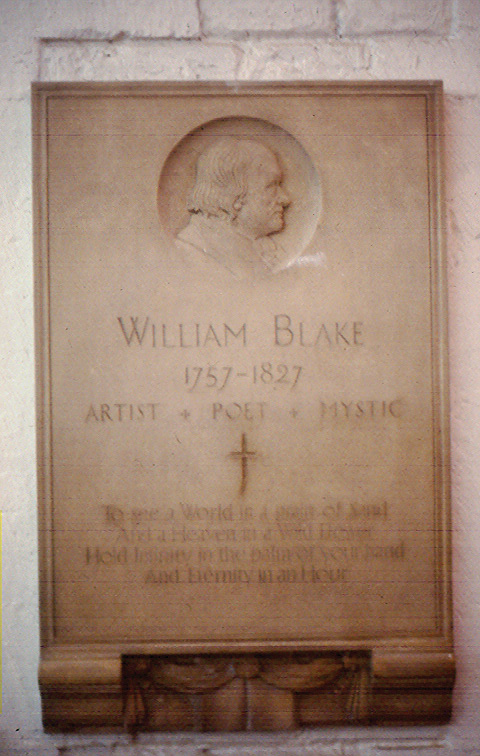
William Blake's memorial plaque in St. Paul's Cathedral, London including the first stanza of Blake's "Auguries of Innocence."
William Blake 1757–1827 Artist + Poet + Mystic "To see a world in a grain of sand And a heaven in a wild flower, Hold infinity in the palm of your hand And eternity in an hour."
The British Library includes Blake's Notebook in its Virtual Books collection. On pages 29 and 30, you can see a draft copy of "The Tyger" and on page 3, sketches of tigers. The William Blake Archive provides digital images of Songs of Innocence and Experience and of Blake's other poetic works that allow you to read the works as Blake intended, with the accompanying engravings.
Illustrated Text
- "Songs of Innocence 1789." The William Blake Archive. Editors: Morris Eaves, University of Rochester; Robert Essick, University of California, Riverside; Joseph Viscomi, University of North Carolina at Chapel Hill. Library of Congress.
- "Songs of Innocence and Experience." The William Blake Archive. Editors: Morris Eaves, University of Rochester; Robert Essick, University of California, Riverside; Joseph Viscomi, University of North Carolina at Chapel Hill. Library of Congress.
- "William Blake Online." Tate Britain.
Songs of Innocence and Experience
Although Blake is considered a pre-Romantic poet, his poetry exhibits many of the characteristics of Romantic poetry.
Like many late 18th-century and 19th-century writers, Blake abhorred the effects the Industrial Revolution had on the physical environment and, more importantly, on the people caught in a time of radical change in the ways of living and making a living their families had pursued for generations. Child labor issues figure prominently in Blake's Songs of Innocence and Experience. The Victorian Web's section on child labor includes testimony from 1819 Parliamentary hearings on the Chimney Sweepers' Regulation Bill. With his Romantic sensibility, Blake puts a human face on the debate, encouraging the reader to think of the situation in terms of individuals—Tom, Dick, Joe, Ned, and Jack—innocent children living lives of inhumane hardship.
Key Takeaways
- William Blake created his poetry as an integral part of his artwork.
- Blake's title pinpoints the dichotomy between the states of innocence and of experience that, according to the work's subtitle, characterize the human soul.
- Although often considered a pre-Romantic poet, Blake's work exemplifies many characteristics of Romantic poetry.
Exercises
-
Blake titles his collection of poems Songs of Innocence and Experience. His subtitle explains that the poems are "Shewing [showing] the Two Contrary [opposite] States of the Human Soul." Both "innocence" and "experience" are part of each human soul.
- What do you think he means when he uses the terms "innocence" and "experience"?
- Do "innocence" and "experience" belong to certain ages of a person's life, or to one's attitude about life, or to the experiences that happen to a person in life, or other circumstances?
-
After reading all of the Songs of Innocence and Songs of Experience, re-read the following pairs of poems as companion poems:
- "The Lamb" and "The Tyger"
- "The Chimney Sweeper" and "The Chimney Sweeper"
- "Holy Thursday" and "Holy Thursday"
- "Nurse's Song" and "Nurse's Song"
Why does the first poem of each pair belong in the innocence category and the second in the experience category?
- While "The Lamb" is a question and answer poem, its companion "The Tyger" is only a question poem. Why?
-
In "The Lamb," who does the speaker refer to in the following lines?
He is called by thy name,
For he calls himself a Lamb:
He is meek & he is mild,
He became a little child:
- In the Innocence "The Chimney Sweeper," why does Tom dream of being locked in "coffins of black"? Note how the young boys imagine Heaven; how does this add to the pathos of the poem? Explain the final line of the poem: "So if all do their duty they need not fear harm"; to whom does the speaker refer with the word "all"?
- In the Experience "The Chimney Sweeper," who does the boy seem to blame for his situation?
-
In the Innocence "Holy Thursday," the poem describes an apparently beautiful sight: the poor children of London cleaned up and dressed in their best clothing being marched to a church service to sing praises. In the Experience "Holy Thursday," the poem begins with a question:
Is this a holy thing to see
In a rich and fruitful land,
Babes reduced to misery,
Fed with cold and usurous hand?
What is the relationship of the two poems?
- What characteristics of Romanticism do you find in Songs of Innocence and Experience?
Resources
General Information
- The William Blake Archive. Editors: Morris Eaves, University of Rochester; Robert Essick, University of California, Riverside; Joseph Viscomi, University of North Carolina at Chapel Hill. Library of Congress.
Biography
- "About Blake." The Blake Society.
- "Chronology." The William Blake Archive. Editors: Morris Eaves, University of Rochester; Robert Essick, University of California, Riverside; Joseph Viscomi, University of North Carolina at Chapel Hill. Library of Congress.
- William Blake (1757–1827). The British Museum.
- "William Blake (1757–1827)." Denise Vultee. The William Blake Archive. Editors: Morris Eaves, University of Rochester; Robert Essick, University of California, Riverside; Joseph Viscomi, University of North Carolina at Chapel Hill. Library of Congress.
Illustrated Texts
- "Songs of Innocence 1789." The William Blake Archive. Editors: Morris Eaves, University of Rochester; Robert Essick, University of California, Riverside; Joseph Viscomi, University of North Carolina at Chapel Hill. Library of Congress.
- "Songs of Innocence and Experience." The William Blake Archive. Editors: Morris Eaves, University of Rochester; Robert Essick, University of California, Riverside; Joseph Viscomi, University of North Carolina at Chapel Hill. Library of Congress.
- "William Blake Online." Tate Britain.
Art Information
- "Blake's Notebooks." Virtual Books. British Library.
- "Illuminated Printing." The William Blake Archive. Editors: Morris Eaves, University of Rochester; Robert Essick, University of California, Riverside; Joseph Viscomi, University of North Carolina at Chapel Hill. Library of Congress.
- "William Blake and the Illuminated Book." The Electronic Labyrinth. Christopher Keep, Tim McLaughlin, Robin Parmar. Institute for Advanced Technology in the Humanities. University of Virginia.
6.4 Robert Burns (1759–1796)
PLEASE NOTE: This book is currently in draft form; material is not final.
Learning Objectives
- Understand Robert Burns's position as the national poet of Scotland and his appeal to Romantic-era audiences as a natural poet, an example of primitivism.
- Identify characteristics of Romanticism in Burns's poetry.
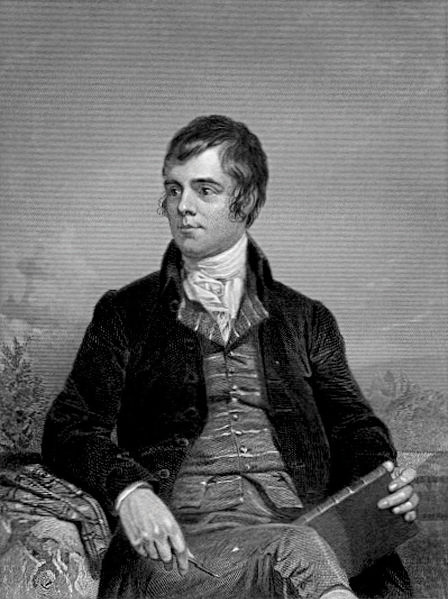
Duyckinick, Evert A. Portrait Gallery of Eminent Men and Women in Europe and America.
New York: Johnson, Wilson & Company, 1873.
Robert Burns is the national poet of Scotland. Although his poems are somewhat difficult to read because of the Scottish dialect, that dialect is one of the reasons Burns is a central pre-Romantic figure. Long before the popularity of 20th-century multi-culturalism, Burns preserved in his poetry the Scottish language, culture, and heritage. Burns embodies the concept of Romantic primitivism, and his poetry exemplifies the glorification of the common man, the individual educated by life and nature.
Biography
The son of a Scottish farmer, Robert Burns was born in this farmhouse in Alloway, Scotland in 1759. One end of the building housed the animals; the other, the family.

Burns attended the local school, had occasional tutors, and read voraciously. Because he lacked formal education, he was viewed as a natural poet, the exemplification of a Romantic ideal: a primitive plowman, close to nature, as capable of writing perceptive poetry as the university-educated aristocrat. After the publication of his Kilmarnock volume of poetry, Burns's fame soared, and he was in demand in the highest social circles in Scotland.
Known as the National Poet of Scotland, Robbie Burns celebrated the folk legends, the history, and the language of Scotland. His poetry also glorified nature, the common individual, and rural Scottish life.
A stained glass window in St. Giles Church in Edinburgh, Scotland honors Burns, as do numerous monuments in Edinburgh, Alloway, and Dumfries where Burns lived.
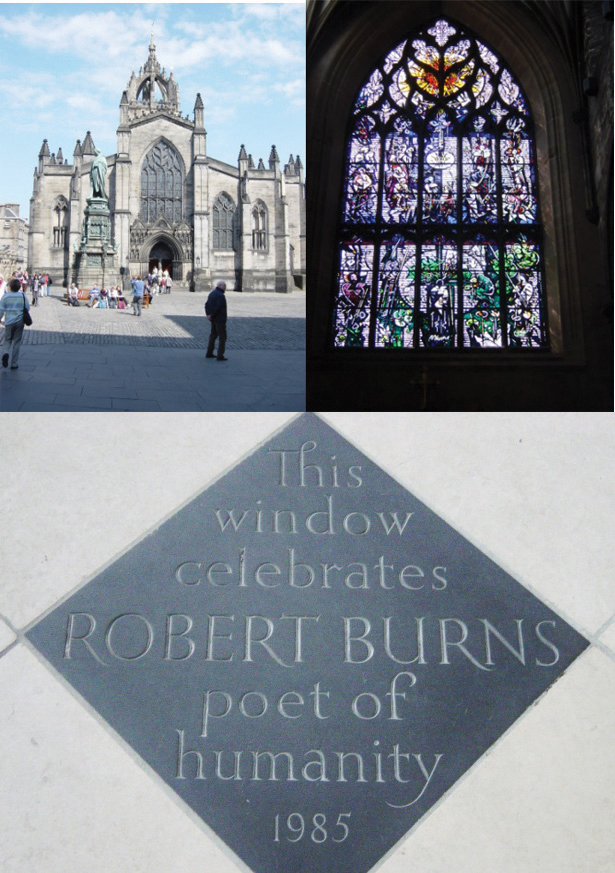
Audio
In addition to reading Burns's poetry, listen to recordings in the Scottish dialect.
- "Kevin McFadden Reads 'To a Mouse' by Robert Burns." Poets on Poets. Tilar Mazzeo, ed. Romantic Circles.
- "Robert Burns 250th Anniversary Collection." LibriVox.

The Poetic Genius of my Country found me at the plough and threw her inspiring mantle over me. She bade me sing the loves, the joys, the rural scenes and rural pleasures of my native soil, in my native tongue; I tuned my wild, artless notes, as she inspired
…—quotation from a letter by Robert Burns.
"To a Mouse" and "To a Louse"
Both "To a Mouse" and "To a Louse" have a moral to the story.
In "To a Mouse," a farmer plowing his field turns up a mouse's nest, and the poem reports his speech to the mouse. Sympathetic, the farmer recognizes what was a popular idea among Romantic poets, the idea of man and nature in a "social union." In Burns's frequently quoted lines, the farmer states that even the most careful plans may "go astray" because of unforeseen circumstances:
The best-laid schemes o' mice an' men Gang aft agley, An' lea'e us nought but grief an' pain, For promis'd joy!
In the final stanza, the farmer notes, despite this realization that neither man nor mouse can plan the future with any certainty, the mouse is still more blessed than the man. The present only affects the mouse; people, however, look back at the past and worry about the future.

Auld Kirk in Alloway, setting of Tam O'Shanter's ghostly encounter.
In "To a Louse," the moral is in lines 43–44 as Burns laments that people might behave differently if only we could see ourselves in the same way that others see us. The method he chooses to convey this message is by relating the story of Jeany, a young woman sitting in a church service, aware that people are staring at her. Thinking they are admiring her bonnet and her beauty, Jeany is unaware that they really are watching a louse making its way across her bonnet. The narrator believes that lice belong on poor beggars, not on fine ladies. The louse, however, by its presence on Jeany makes the point that nature is indifferent to social status.
"Tam O'Shanter"
Robert Burns sets his folktale "Tam O'Shanter" in his hometown of Alloway. The story tells of a foolish, drunken man who, to his detriment, ignores the good advice of his wife, stays out late drinking too much, and suffers, as does his brave horse Meg, a supernatural encounter.
Video Clip 3
Robert Burns Tam O'Shanter
(click to see video)
View a video mini-lecture on "Tam O'Shanter."
Key Takeaways
- Robert Burns is the National Poet of Scotland because he celebrated his country's language, folklore, and rural life.
- Burns's reputation as a natural poet epitomized the Romantic-era ideal of primitivism.
Exercises
- What characteristics of Romantic poetry do you find in "To a Mouse" and "To a Louse"?
- How would you describe the character Tam O'Shanter?
- Who is Maggie (also referred to as Meg)? What did Maggie lose in her flight to save Tam O'Shanter?
- What alerted the witches to Tam's presence?
- Whom would you describe as the hero of "Tam O'Shanter"?
- What is the "moral" of "Tam O'Shanter"?
- How does Burns's telling of "Tam O'Shanter" correspond with Romantic ideas about poetry and poets?
Resources
6.5 Mary Wollstonecraft (1759–1797)
PLEASE NOTE: This book is currently in draft form; material is not final.
Learning Objectives
- Recognize the unconventional nature of Mary Wollstonecraft's beliefs, as expressed in A Vindication of the Rights of Woman for her time period.
- Correlate the opinions expressed in A Vindication of the Rights of Woman with the characteristics of Romanticism.
The same philosophy that led to the American Revolution and the French Revolution, the impetus for equality that was a focusing tenet of Romanticism, led many to believe that women should be included in the granting of political and social rights. Although Mary Wollstonecraft wrote novels, she is best remembered for her political treatises such as A Vindication of the Rights of Woman.

James Heath (1757–1834), engraved from the painting of John Opie (1761–1807).
Biography
Wollstonecraft's personal experiences mirror the state of women's rights in the late 18th/early 19th centuries. As the second child, Mary Wollstonecraft from early childhood resented her elder brother's education and inheritance. Denied the formal education her brother enjoyed, Wollstonecraft, through her reading, obtained an education equal to or perhaps better than many women of her time period and social class. Because of her father's declining financial situation, Wollstonecraft earned her own living, working in the only jobs available to women, such as a lady's companion and a governess, which she found particularly distasteful. Later in her life she attempted to establish schools for girls.
In her personal life as well as her professional life, Wollstonecraft was unconventional and attracted the disdain of traditional society. She gave birth to an illegitimate daughter, allowing people to believe she was married to the child's father.

Portrait by John Opie.
Wollstonecraft's two suicide attempts testify to her dissatisfaction with life in a world which disagreed so adamantly with her ideas of radical freedom in moral and social behavior. Later when she became pregnant with William Godwin's child, they married, even though both advocated free love without marriage. The couple's marriage revealed that Wollstonecraft's first marriage was a pretense, and she again found herself publicly ostracized. Wollstonecraft died from complications of childbirth a month after her daughter with Godwin was born. Their daughter, Mary Wollstonecraft Godwin, grew up to marry the poet Shelley and to write the novel Frankenstein.
Text of A Vindication of the Rights of Woman
- 1792 A Vindication of the Rights of Women by Mary Wollstonecraft. Great Voyages: The History of Western Philosophy from 1492 to 1776. Bill Uzgalis, Oregon State University. searchable text.
- "A Vindication of the Rights of Woman With Strictures on Political and Moral Subjects." Bartleby.com. rpt. from Boston: Peter Edes, 1792.
- "Modern History Sourcebook: Mary Woolstonecraft [sic]: A Vindication of the Right of Women." Internet Modern History Sourcebook. Paul Halsall, Fordham University.
- Vindication of the Rights of Woman by Mary Wollstonecraft. Project Gutenberg.
- "Wollstonecraft, Mary, 1759–1797 . A Vindication of the Rights of Woman / by Mary Wollstonecraft." Electronic Text Center. University of Virginia Library.
A Vindication of the Rights of Woman
Excerpt from the Introduction
After considering the historic page, and viewing the living world with anxious solicitude, the most melancholy motions of sorrowful indignation have depressed my spirits, and I have sighed when obliged to confess, that either nature has made a great difference between man and man, or that the civilization, which has hitherto taken place in the world, has been very partial. I have turned over various books written on the subject of education, and patiently observed the conduct of parents and the management of schools; but what has been the result? a profound conviction, that the neglected education of my fellow creatures is the grand source of the misery I deplore; and that women in particular, are rendered weak and wretched by a variety of concurring causes, originating from one hasty conclusion. The conduct and manners of women, in fact, evidently prove, that their minds are not in a healthy state; for, like the flowers that are planted in too rich a soil, strength and usefulness are sacrificed to beauty; and the flaunting leaves, after having pleased a fastidious eye, fade, disregarded on the stalk, long before the season when they ought to have arrived at maturity. One cause of this barren blooming I attribute to a false system of education, gathered from the books written on this subject by men, who, considering females rather as women than human creatures, have been more anxious to make them alluring mistresses than rational wives; and the understanding of the sex has been so bubbled by this specious homage, that the civilized women of the present century, with a few exceptions, are only anxious to inspire love, when they ought to cherish a nobler ambition, and by their abilities and virtues exact respect.
In a treatise, therefore, on female rights and manners, the works which have been particularly written for their improvement must not be overlooked; especially when it is asserted, in direct terms, that the minds of women are enfeebled by false refinement; that the books of instruction, written by men of genius, have had the same tendency as more frivolous productions; and that, in the true style of Mahometanism, they are only considered as females, and not as a part of the human species, when improvable reason is allowed to be the dignified distinction, which raises men above the brute creation, and puts a natural sceptre in a feeble hand.
Yet, because I am a woman, I would not lead my readers to suppose, that I mean violently to agitate the contested question respecting the equality and inferiority of the sex; but as the subject lies in my way, and I cannot pass it over without subjecting the main tendency of my reasoning to misconstruction, I shall stop a moment to deliver, in a few words, my opinion. In the government of the physical world, it is observable that the female, in general, is inferior to the male. The male pursues, the female yields—this is the law of nature; and it does not appear to be suspended or abrogated in favour of woman. This physical superiority cannot be denied—and it is a noble prerogative! But not content with this natural pre-eminence, men endeavour to sink us still lower, merely to render us alluring objects for a moment; and women, intoxicated by the adoration which men, under the influence of their senses, pay them, do not seek to obtain a durable interest in their hearts, or to become the friends of the fellow creatures who find amusement in their society.
I am aware of an obvious inference: from every quarter have I heard exclamations against masculine women; but where are they to be found? If, by this appellation, men mean to inveigh against their ardour in hunting, shooting, and gaming, I shall most cordially join in the cry; but if it be, against the imitation of manly virtues, or, more properly speaking, the attainment of those talents and virtues, the exercise of which ennobles the human character, and which raise females in the scale of animal being, when they are comprehensively termed mankind—all those who view them with a philosophical eye must, I should think, wish with me, that they may every day grow more and more masculine.
This discussion naturally divides the subject. I shall first consider women in the grand light of human creatures, who, in common with men, are placed on this earth to unfold their faculties; and afterwards I shall more particularly point out their peculiar designation.
I wish also to steer clear of an error, which many respectable writers have fallen into; for the instruction which has hitherto been addressed to women, has rather been applicable to LADIES, if the little indirect advice, that is scattered through Sandford and Merton, be excepted; but, addressing my sex in a firmer tone, I pay particular attention to those in the middle class, because they appear to be in the most natural state. Perhaps the seeds of false refinement, immorality, and vanity have ever been shed by the great. Weak, artificial beings raised above the common wants and affections of their race, in a premature unnatural manner, undermine the very foundation of virtue, and spread corruption through the whole mass of society! As a class of mankind they have the strongest claim to pity! the education of the rich tends to render them vain and helpless, and the unfolding mind is not strengthened by the practice of those duties which dignify the human character. They only live to amuse themselves, and by the same law which in nature invariably produces certain effects, they soon only afford barren amusement.
But as I purpose taking a separate view of the different ranks of society, and of the moral character of women, in each, this hint is, for the present, sufficient; and I have only alluded to the subject, because it appears to me to be the very essence of an introduction to give a cursory account of the contents of the work it introduces.
My own sex, I hope, will excuse me, if I treat them like rational creatures, instead of flattering their FASCINATING graces, and viewing them as if they were in a state of perpetual childhood, unable to stand alone. I earnestly wish to point out in what true dignity and human happiness consists—I wish to persuade women to endeavour to acquire strength, both of mind and body, and to convince them, that the soft phrases, susceptibility of heart,
delicacy of sentiment, and refinement of taste, are almost synonymous with epithets of weakness, and that those beings who are only the objects of pity and that kind of love, which has been termed its sister, will soon become objects of contempt.
Dismissing then those pretty feminine phrases, which the men condescendingly use to soften our slavish dependence, and despising that weak elegancy of mind, exquisite sensibility, and sweet docility of manners, supposed to be the sexual characteristics of the weaker vessel, I wish to show that elegance is inferior to virtue, that the first object of laudable ambition is to obtain a character as a human being, regardless of the distinction of sex; and that secondary views should be brought to this simple touchstone.
This is a rough sketch of my plan; and should I express my conviction with the energetic emotions that I feel whenever I think of the subject, the dictates of experience and reflection will be felt by some of my readers. Animated by this important object, I shall disdain to cull my phrases or polish my style—I aim at being useful, and sincerity will render me unaffected; for wishing rather to persuade by the force of my arguments, than dazzle by the elegance of my language, I shall not waste my time in rounding periods, nor in fabricating the turgid bombast of artificial feelings, which, coming from the head, never reach the heart. I shall be employed about things, not words! and, anxious to render my sex more respectable members of society, I shall try to avoid that flowery diction which has slided from essays into novels, and from novels into familiar letters and conversation.
These pretty nothings, these caricatures of the real beauty of sensibility, dropping glibly from the tongue, vitiate the taste, and create a kind of sickly delicacy that turns away from simple unadorned truth; and a deluge of false sentiments and over-stretched feelings, stifling the natural emotions of the heart, render the domestic pleasures insipid, that ought to sweeten the exercise of those severe duties, which educate a rational and immortal being for a nobler field of action.
The education of women has, of late, been more attended to than formerly; yet they are still reckoned a frivolous sex, and ridiculed or pitied by the writers who endeavour by satire or instruction to improve them. It is acknowledged that they spend many of the first years of their lives in acquiring a smattering of accomplishments: meanwhile, strength of body and mind are sacrificed to libertine notions of beauty, to the desire of establishing themselves, the only way women can rise in the world—by marriage. And this desire making mere animals of them, when they marry, they act as such children may be expected to act: they dress; they paint, and nickname God's creatures. Surely these weak beings are only fit for the seraglio! Can they govern a family, or take care of the poor babes whom they bring into the world?

Title page from the first American edition 1792.
Key Takeaways
- Because of the strictures of her society, Mary Wollstonecraft was largely self-educated and forced to work in traditional women's jobs which she disliked.
- Wollstonecraft evinces the Romantic characteristics of primitivism and individualism as well as exemplifying tenets from Wordsworth's Preface to Lyrical Ballads such as the use of common language and writing for and about common people.
Exercises
- In the first paragraph of A Vindication, Wollstonecraft uses an analogy to illustrate the thesis of her essay: she compares women as they are treated by society to flowers. What is the purpose of this analogy?
- This analogy leads her to the thesis of her essay. Identify her thesis.
- In paragraph six, Wollstonecraft specifies her audience. To what group of women is she writing? Why does she choose that group of women?
- How, in paragraph 8, does Wollstonecraft say women usually are treated, and how does she plan to be different?
- What type of language does Wollstonecraft intend to use in her essay? Compare her choice of language to that advocated by Wordsworth in his 1802 Preface to Lyrical Ballads.
- Wollstonecraft argues that because women are not educated they have only one means to "rise in the world." What is that means?
Resources
6.6 William Wordsworth (1770–1850)
PLEASE NOTE: This book is currently in draft form; material is not final.
Charlotte Smith, William Blake, and Robert Burns are sometimes referred to as pre-Romantic writers. Although their works display the characteristics of Romantic poetry, they pre-date Wordsworth and Coleridge, whose work is considered the beginning of British Romantic literature.
"Lines Composed a Few Miles Above Tintern Abbey"
With the passage of the 1534 Act of Supremacy, King Henry VIII ordered that selected monasteries and abbeys in England be closed and the occupants dispersed. Like many others, Tintern Abbey stood vacant and gradually fell into decay. Over two hundred years later, Wordsworth came upon the ruins of Tintern Abbey while on a hiking trip. In the opening lines of the poem, the speaker states that after five years he has returned to Tintern Abbey.
Video Clip 4
Wordsworth's Lines Composed a Few Miles Above Tintern Abbey
(click to see video)
View a video mini-lecture on "Lines Composed a Few Miles Above Tintern Abbey."
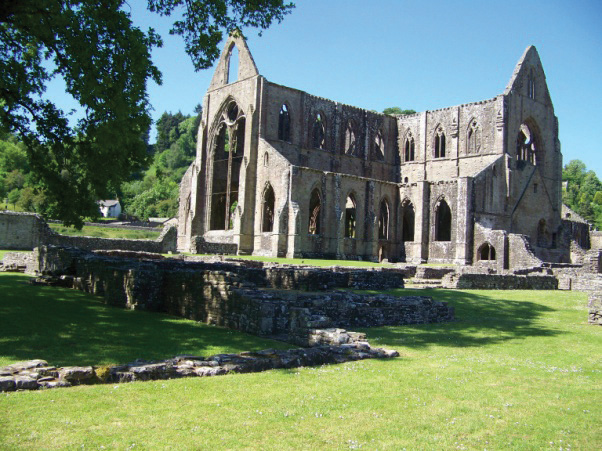
"Lines" is an example of a pattern found in much Romantic poetry: an observation of nature followed by a meditation inspired by that observation.
The following are excerpts from "Lines," not the entire poem.
Stanza 1 (lines 1–22): the speaker describes the beautiful scene. Note the descriptive details. This stanza is the observation of nature.
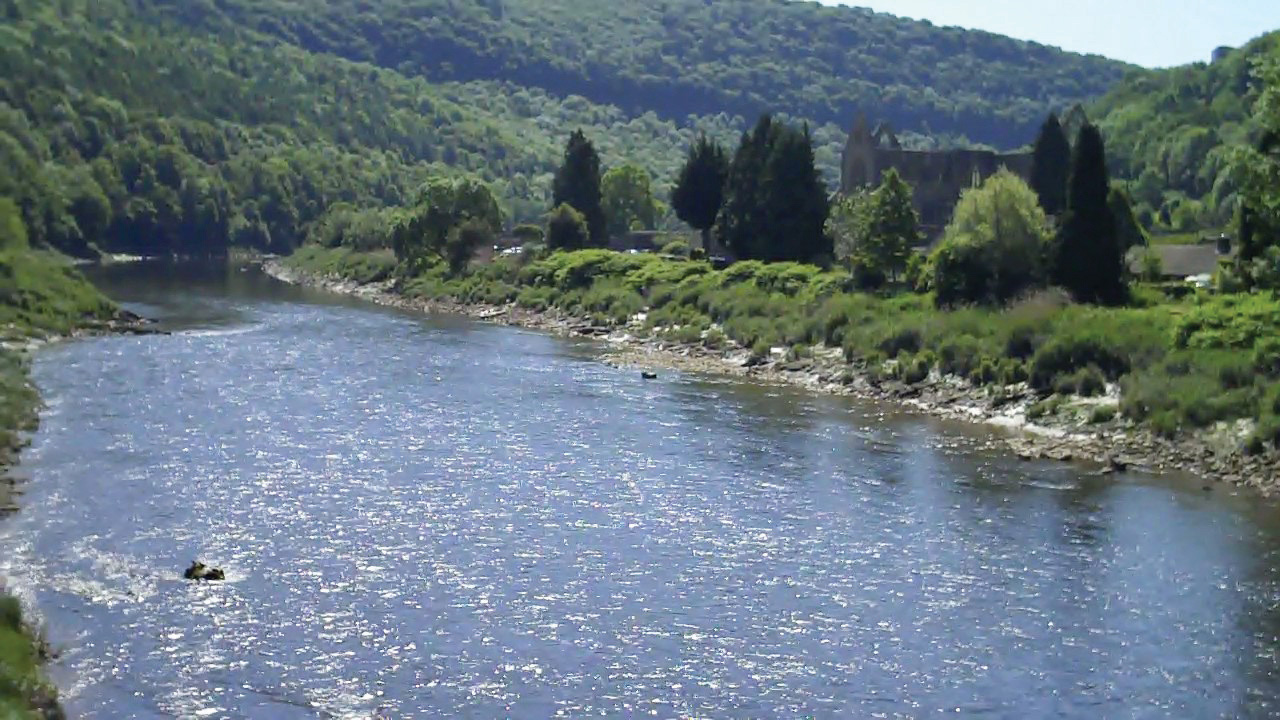
| Five years have past; five summers, with the length | |
| Of five long winters! and again I hear | |
| These waters, rolling from their mountain-springs | |
| With a soft inland murmur.—Once again | |
| Do I behold these steep and lofty cliffs, | 5 |
| That on a wild secluded scene impress | |
| Thoughts of more deep seclusion; and connect | |
| The landscape with the quiet of the sky. | |
| The day is come when I again repose | |
| Here, under this dark sycamore, and view | 10 |
| These plots of cottage-ground, these orchard-tufts, | |
| Which at this season, with their unripe fruits, | |
| Are clad in one green hue, and lose themselves | |
| 'Mid groves and copses. Once again I see | |
| These hedge-rows, hardly hedge-rows, little lines | 15 |
| Of sportive wood run wild: these pastoral farms, | |
| Green to the very door; and wreaths of smoke | |
| Sent up, in silence, from among the trees! | |
| With some uncertain notice, as might seem | |
| Of vagrant dwellers in the houseless woods, | 20 |
| Or of some Hermit's cave, where by his fire | |
| The Hermit sits alone. |
Stanza 2 (lines 22–49): This stanza begins the meditation—a philosophical strain of thought inspired by the natural scene. The speaker realizes that although he hasn't seen Tintern Abbey for five years, he has remembered the beautiful scene even when he's back in the busy, noisy city enduring the stress of daily life. When he remembers the beauty of nature, he feels again the calmness, the "tranquil restoration," of being in nature. This idea that nature, even the memory of nature, can cause us to feel tranquil is a central concept of Romanticism.
| These beauteous forms, |
| Through a long absence, have not been to me |
| As is a landscape to a blind man's eye: |
| But oft, in lonely rooms, and 'mid the din |
| Of towns and cities, I have owed to them |
| In hours of weariness, sensations sweet, |

| Felt in the blood, and felt along the heart; |
| And passing even into my purer mind, |
| With tranquil restoration:—feelings too |
| Of unremembered pleasure: such, perhaps, |
| As have no slight or trivial influence |
| On that best portion of a good man's life, |
| His little, nameless, unremembered, acts |
| Of kindness and of love. |
Stanza 4 (lines 58–111): The speaker reiterates the same concept in lines 64–67. He realizes that while he stands looking at the beauty of Tintern Abbey he is receiving two types of pleasure: first, the "present pleasure" of simply enjoying the beauty at the moment; and second, the pleasure of storing up mental "life and food for future years" when he returns to the city and calls up the scene in his memory.
| While here I stand, not only with the sense | |
| Of present pleasure, but with pleasing thoughts | 65 |
| That in this moment there is life and food | |
| For future years. |
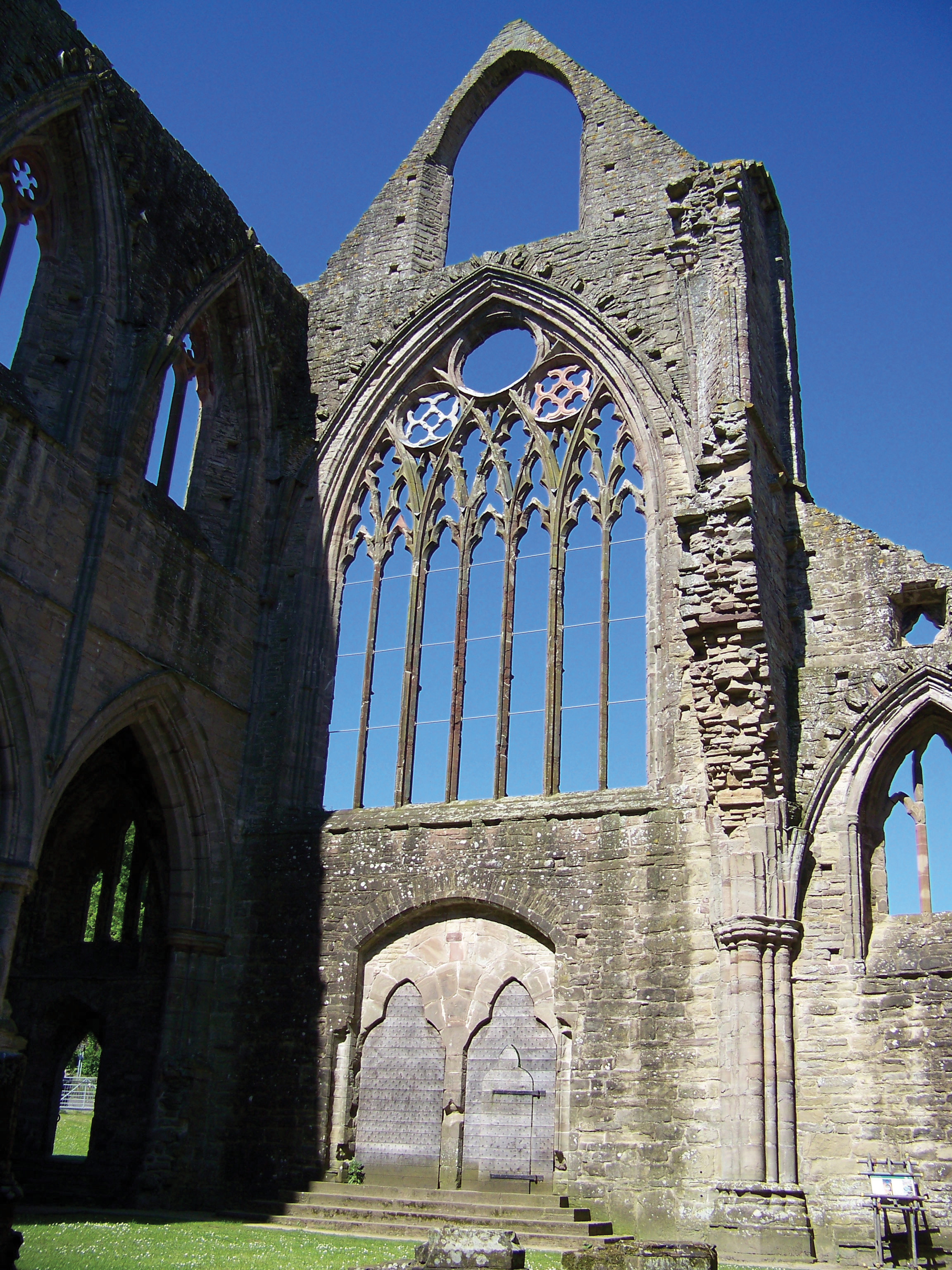
Later in stanza 4, the speaker explains why remembering the beauties of nature can cause him to feel tranquil. First, in lines 90–93, he acknowledges that nature brings to mind "the still, sad music of humanity." Nature is important because it turns his thoughts to humanity. Second, he informs the reader why nature draws his attention to the needs of humanity. In lines 107–111, he states that in nature he recognizes a divine presence, what he calls "the guide, the guardian of my heart, and soul of all my moral being." Nature is a means of perceiving a spiritual presence in the world. This passage encapsulates the concept of Romantic mysticism.
| For I have learned | 90 |
| To look on nature, not as in the hour | |
| Of thoughtless youth; but hearing oftentimes | |
| The still, sad music of humanity, | |
| Nor harsh nor grating, though of ample power | |
| To chasten and subdue. And I have felt | 95 |
| A presence that disturbs me with the joy | |
| Of elevated thoughts: a sense sublime | |
| Of something far more deeply interfused, | |
| Whose dwelling is the light of setting suns, | |
| And the round ocean and the living air, | 100 |
| And the blue sky, and in the mind of man: | |
| A motion and a spirit, that impels | |
| All thinking things, all objects of all thought, | |
| And rolls through all things. Therefore am I still | |
| A lover of the meadows and the woods, | 105 |
| And mountains; and of all that we behold | |
| From this green earth; of all the mighty world | |
| Of eye and ear,—both what they half create, | |
| And what perceive; well pleased to recognise | |
| In nature and the language of the sense, | 110 |
| The anchor of my purest thoughts, the nurse, | |
| The guide, the guardian of my heart, and soul | |
| Of all my moral being. |
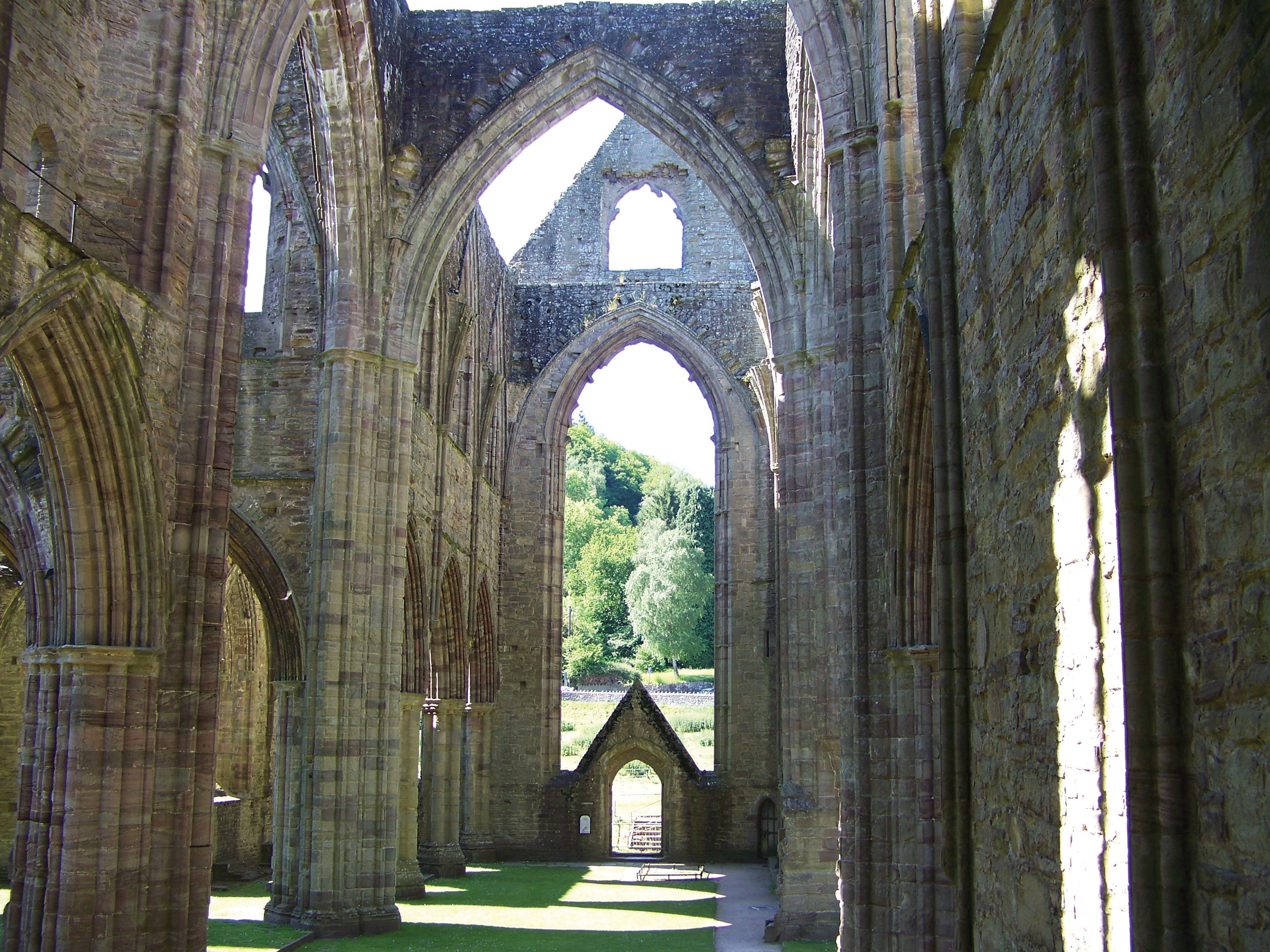
Stanza 5: The speaker directly addresses his sister (presumably Wordsworth and his sister Dorothy), hoping that she also will recognize both the beauty and the spiritual presence in nature. The benefit of being close to nature is that we are also close to God, and therefore the trials of daily life will not "disturb our cheerful faith." Note the evils that beset individuals the speaker lists in lines131–134. The speaker trusts his sister will find in nature the same tranquil restoration he has.
| My dear, dear Sister! and this prayer I make | |
| Knowing that Nature never did betray | 125 |
| The heart that loved her; 'tis her privilege | |
| Through all the years of this our life, to lead | |
| From joy to joy: for she can so inform | |
| The mind that is within us, so impress | |
| With quietness and beauty, and so feed | 130 |
| With lofty thoughts, that neither evil tongues, | |
| Rash judgments, nor the sneers of selfish men, | |
| Nor greetings where no kindness is, nor all | |
| The dreary intercourse of daily life, | |
| Shall e'er prevail against us, or disturb | 135 |
| Our cheerful faith, that all which we behold | |
| Is full of blessings. |
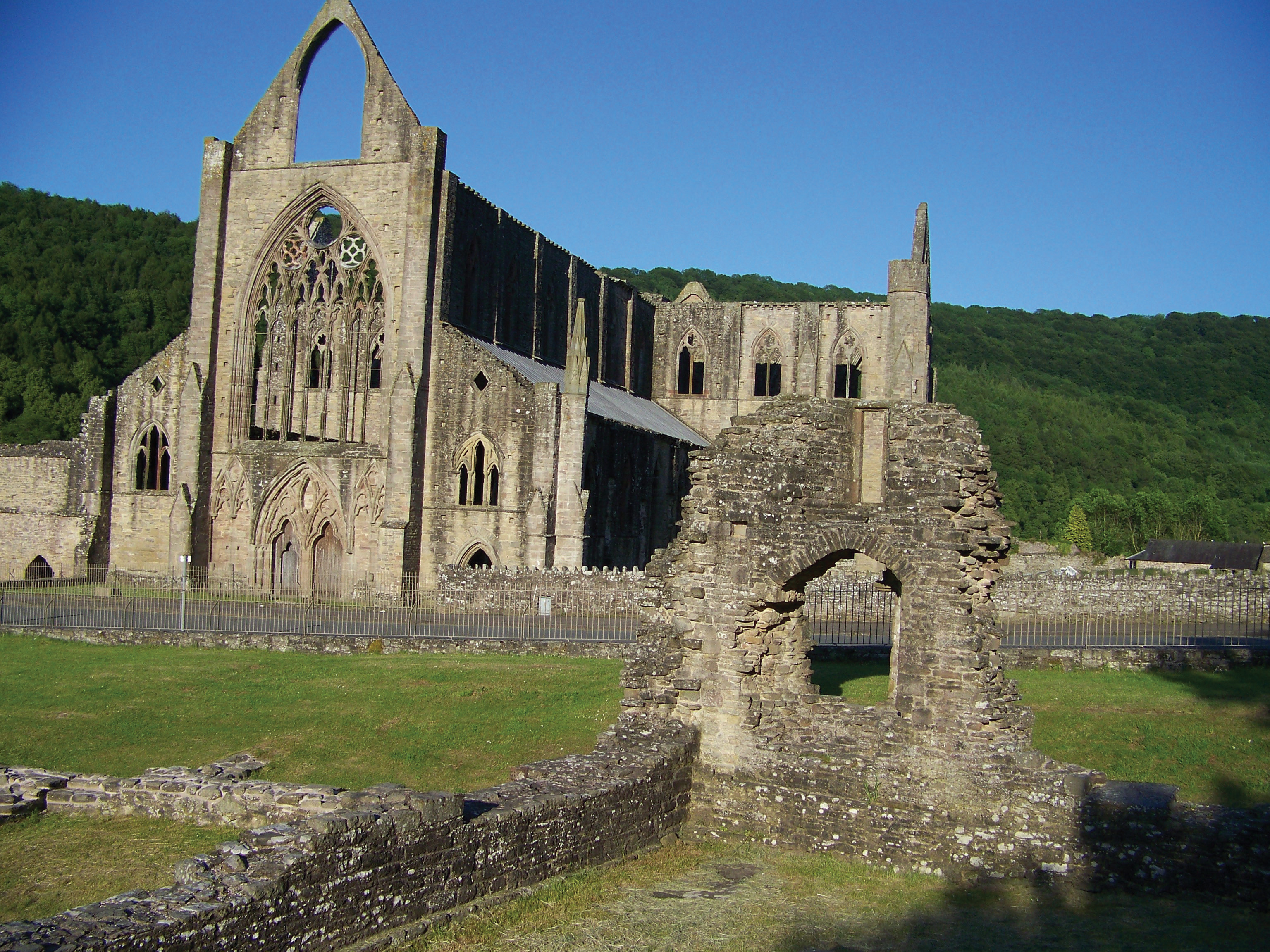
"Michael"
Video Clip 5
William Wordsworth's Michael A Pastoral Poem
(click to see video)
View a video mini-lecture on "Michael."
"Michael" is a narrative poemA poem that tells a story. , a poem that tells a story, about the misfortune of a simple common man and his family. Wordsworth subtitles the poem "A Pastoral Poem." The term pastoralPoetry about shepherds, sheep, and the simple pleasures of rural life. refers to poetry about shepherds, sheep, and the simple pleasures of rural life. In this poem, Wordsworth not only writes about one individual's tragedy but also about an entire class of people whose lives are disrupted by the Industrial Revolution. For centuries, many families like Michael's had made their living from their land and their flocks of sheep. The men tended the sheep and the women spun wool and wove cloth to sell. With the coming of machinery, spinning and weaving could be accomplished much more quickly and cheaply in factories. Many young people, no longer able to make a living in the country, went to work in the cities.
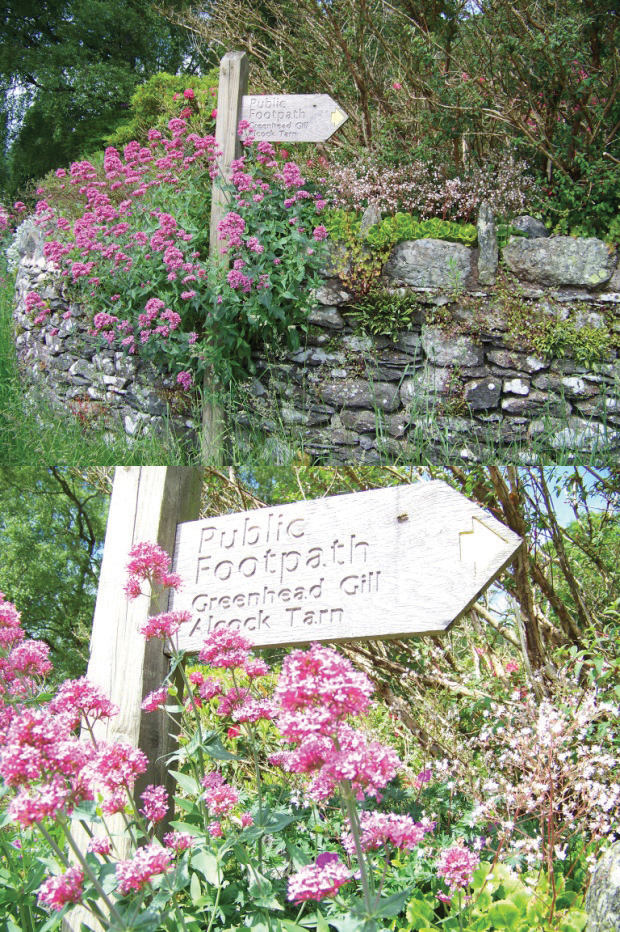
The beginning of the trail which leads to Greenhead Gill[Ghyll], the pathway Wordsworth walked where he saw the "heap of unhewn stone" and was reminded of the story of Michael the shepherd.
A convention of the pastoral mode is the portrayal of life in the city, or in the court as in Marlowe's poem "The Passionate Shepherd to His Love," as evil and corrupt—the view of the courtier caught up in and tired of the intrigue and subterfuge of the court, longing to escape into the beautiful, peaceful countryside, totally unaware of the realities of the hard lives of shepherds.
Wordsworth draws on this convention when he pictures the son Luke having to go to the city where he falls into evil and is unable to come home to the pure life of the countryside.
Note the beginning lines of the poem. Wordsworth describes the scene and then focuses our attention on a specific object: "a straggling heap of unhewn stones." This specific object then, this stack of rough stones, prompts him to remember and to tell us the story of Michael, the shepherd.
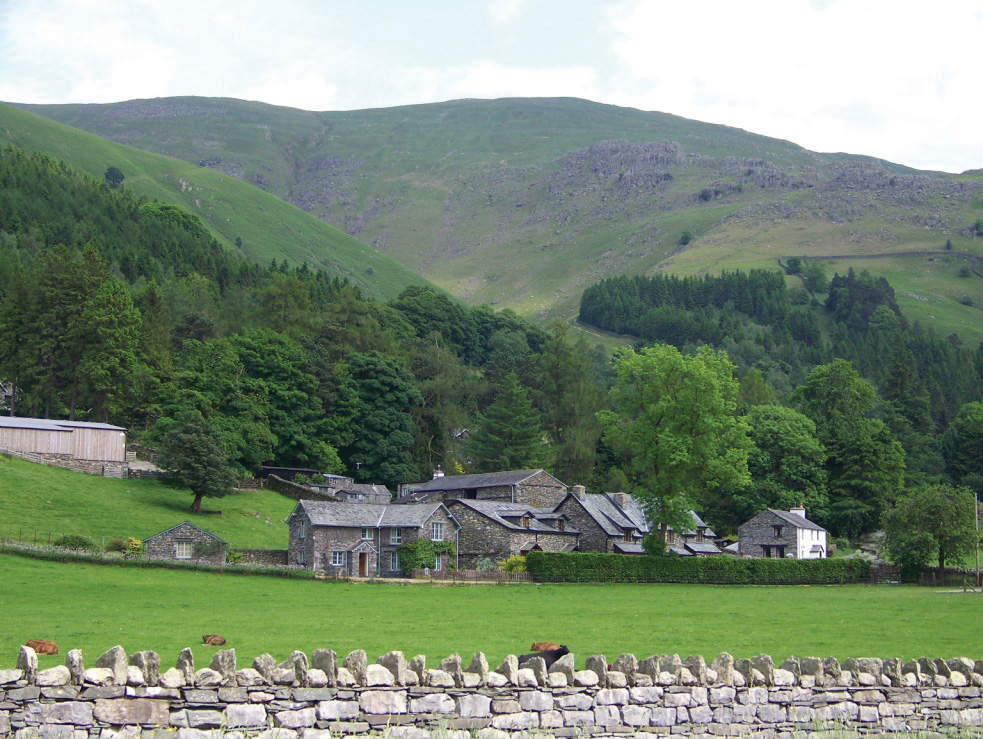
The valley between these hills leads to Greenhead Ghyll.
"I Wandered Lonely as a Cloud"
This poem is a lyric poem. Like "Lines," "I Wandered" follows the pattern of an observation of nature leading to a meditation.
| I wandered lonely as a cloud | |
| That floats on high o'er vales and hills, | |
| When all at once I saw a crowd, | |
| A host, of golden daffodils; | |
| Beside the lake, beneath the trees, | |
| Fluttering and dancing in the breeze. | |
| Continuous as the stars that shine | |
| And twinkle on the milky way, | |
| They stretched in never-ending line | |
| Along the margin of a bay: | 10 |
| Ten thousand saw I at a glance, | |
| Tossing their heads in sprightly dance. | |
| The waves beside them danced; but they | |
| Out-did the sparkling waves in glee: | |
| A poet could not but be gay, | |
| In such a jocund company: | |
| I gazed—and gazed—but little thought | |
| What wealth the show to me had brought: | |
| For oft, when on my couch I lie | |
| In vacant or in pensive mood, | 20 |
| They flash upon that inward eye | |
| Which is the bliss of solitude; | |
| And then my heart with pleasure fills, | |
| And dances with the daffodils. |
In stanzas 1–3, note the descriptive details. Stanza 4 is the meditation, the part of the poem that is philosophical and thoughtful. In this last stanza, the speaker realizes that when he is at home, lying on his couch, he remembers the sight of the daffodils and he feels the same happy emotions he felt when he originally saw them, an example of "emotion recollected in tranquility" which Wordsworth describes in the Preface to Lyrical Ballads.
Key Takeaways
- The work of Wordsworth and Coleridge is considered the beginning of the Romantic Period in British literature.
- The landscape of the Lake District influenced Wordsworth's poetry.
- The pattern of an observation of nature that leads into a meditation is a typical pattern in Romantic poetry.
- "Lines Composed a Few Miles Above Tintern Abbey," first published in Lyrical Ballads, exemplifies the tenets of Romanticism Wordsworth outlined in the 1802 Preface and provides an explanation of Romantic mysticism.
- "Michael" addresses the consequences of the Industrial Revolution on the English countryside and its inhabitants.
Exercises
- What does the poem's narrator see that reminds him of the story of Michael?
- In what ways is "Michael" a pastoral poem?
- Describe Michael's relationship with Luke.
- Why does Luke go to the city?
- Why does Michael have Luke begin laying stones for the sheepfold before he leaves? Identify biblical allusions in this section of the poem. What purpose do these allusions serve?
- What happens to Luke in the city? What happens to Michael and Isabel at the end of the story? What happens to the land Michael tried to save?
- In your opinion, did Michael make the right decision in sending Luke to the city? Why or why not?
- Compare stanza 4 of "I Wandered Lonely as a Cloud" with lines 62–65 of "Tintern Abbey." What similar experience do these two poems describe?
- Identify characteristics of Romanticism in each of these three poems.
- What other Romantic poems follow the pattern of an observation of nature leading into a meditation?
Resources
6.7 Dorothy Wordsworth (1771–1855)
PLEASE NOTE: This book is currently in draft form; material is not final.
Learning Objectives
- Identify tenets of Romanticism in Wordsworth's journal entries.
- Recognize Dorothy Wordsworth's contributions to William Wordsworth's poetry as well as her literary accomplishments in her own right.
Biography
Dorothy Wordsworth was the middle child of five, with two older brothers including William Wordsworth and two younger brothers. Her mother died when she was six, her father when she was twelve. Separated from her brothers, Wordsworth lived in the care of relatives, then worked caring for their children when she was older. After years of seeing her brothers only on holidays, when in her early twenties Wordsworth moved to Alfoxden with William. Here she kept a journal of their activities, including their frequent meetings with Samuel Taylor Coleridge, then living with his wife and child at nearby Nether Stowey.
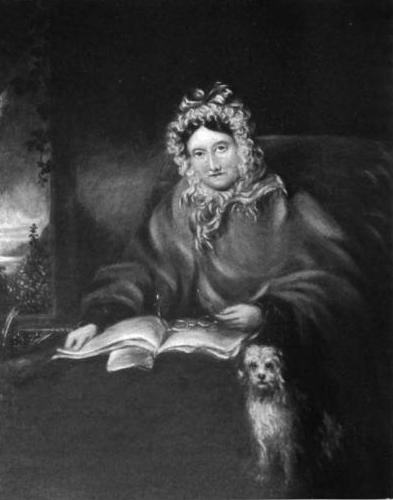
As an unmarried woman, Wordsworth was dependent upon her brother and lived with him even after he married and had his own family. In later life, she became ill, both physically and mentally, and probably addicted to laudanum.
Texts
Journals
Alfoxden Journal
April 15, 1798
Set forward after breakfast to Crookham, and returned to dinner at three o'clock. A fine cloudy morning. Walked about the squire's grounds. Quaint waterfalls about, about which Nature was very successfully striving to make beautiful what art had deformed—ruins, hermitages, etc. etc. In spite of all these things, the dell romantic and beautiful, though everywhere planted with unnaturalised trees. Happily we cannot shape the huge hills, or carve out the valleys according to our fancy.
Journals of Dorothy Wordsworth ed. William Knight. London. Macmillan. 1897. Hathi Trust Digital Library.
In 1798, while William Wordsworth and Coleridge prepared to publish Lyrical Ballads, the volume that would herald the Romantic age in British literature, Dorothy Wordsworth began her Alfoxden journal. Although many of her entries contain only simple notes about daily activities—having dinner, hanging linen—some passages include vivid natural description and commentary on the essence of nature that mirrors Romantic philosophy. Her entry for April 15, for example, voices the anti-neoclassical idea that organic nature is superior to nature transformed by human hands. This April passage was written months before Lyrical Ballads was published, probably in the fall of 1798.
Alfoxden Journal
February 24, 1798
Went to the hill-top. Sat a considerable time overlooking the country towards the sea. The air blew pleasantly round us. The landscape mildly interesting. The Welsh hills capped by a huge range of tumultuous white clouds. The sea, spotted with white, of a bluish grey in general, and streaked with darker lines. The near shores clear; scattered farm houses, half-concealed by green mossy orchards, fresh straw lying at the doors; hay-stacks in the fields. Brown fallows, the springing wheat, like a shade of green over the brown earth, and the choice meadow plots, full of sheep and lambs, of a soft and vivid green; a few wreaths of blue smoke, spreading along the ground; the oaks and beeches in the hedges retaining their yellow leaves; the distant prospect on the land side, islanded with sunshine; the sea, like a basin full to the margin; the dark fresh-ploughed fields; the turnips of a lively rough green. Returned through the wood.
Journals of Dorothy Wordsworth ed. William Knight. London. Macmillan. 1897. Hathi Trust Digital Library.
Alfoxden Journal
February 26, 1798
Coleridge came in the morning, and Mr. and Mrs. Cruikshank; walked with Coleridge nearly to Stowey after dinner. A very clear afternoon. We lay sidelong upon the turf, and gazed on the landscape till it melted into more than natural loveliness. The sea very uniform, of a pale greyish blue, only one distant bay, bright and blue as a sky; had there been a vessel sailing up it, a perfect image of delight. Walked to the top of a high hill to see a fortification. Again sat down to feed upon the prospect; a magnificent scene, curiously spread out for even minute inspection, though so extensive that the mind is afraid to calculate its bounds. A winter prospect shows every cottage, every farm, and the forms of distant trees, such as in summer have no distinguishing mark. On our return, Jupiter and Venus before us. While the twilight still over-powered the light of the moon, we were reminded that she was shining bright above our heads, by our faint shadows going before us. We had seen her on the tops of the hills, melting into the blue sky. Poole called while we were absent.
Journals of Dorothy Wordsworth Vol. 1. ed. William Knight. London. Macmillan. 1897, 1904. Hathi Trust Digital Library.
These two passages evince Wordsworth's descriptive powers. Note the passage in which she describes gazing at nature until it dissolves into a scene of "more than natural loveliness," a beauty that she describes as beyond naturalness, a view that is supernatural. Also note her use of the word "feed" to characterize her absorption of the view, an image that her brother William would use five months later in "Lines Composed a Few Miles Above Tintern Abbey" to convey the experience of storing a natural image to recall in moments of "tranquil restoration."
Grasmere Journals
April 15, 1802
It was a threatening, misty morning, but mild. We set off after dinner from Eusemere. Mrs. Clarkson went a short way with us, but turned back. The wind was furious, and we thought we must have returned. We first rested in the large boathouse, then under a furze bush opposite Mr. Clarkson's. Saw the plough going in the field. The wind seized our breath. The lake was rough. There was a boat by itself floating in the middle of the bay below Water Millock. We rested again in the Water Millock Lane. The hawthorns are black and green, the birches here and there greenish, but there is yet more of purple to be seen on the twigs. We got over into a field to avoid some cows—people working. A few primroses by the roadside—woodsorrel flower, the anemone, scentless violets, strawberries, and that starry, yellow flower which Mrs. C. calls pile wort. When we were in the woods beyond Gowbarrow Park we saw a few daffodils close to the water-side. We fancied that the sea had floated the seeds ashore, and that the little colony had so sprung up. But as we went along there were more and yet more; and at last, under the boughs of the trees, we saw that there was a long belt of them along the shore, about the breadth of a country turnpike road. I never saw daffodils so beautiful. They grew among the mossy stones about and above them; some rested their heads upon these stones, as on a pillow, for weariness; and the rest tossed and reeled and danced, and seemed as if they verily laughed with the wind, that blew upon them over the lake; they looked so gay, ever glancing, ever changing. This wind blew directly over the lake to them. There was here and there a little knot, and a few stragglers higher up; but they were so few as not to disturb the simplicity, unity, and life of that one busy highway. We rested again and again. The bays were stormy, and we heard the waves at different distances, and in the middle of the water, like the sea.…All was cheerless and gloomy, so we faced the storm. At Dobson's I was very kindly treated by a young woman. The landlady looked sour, but it is her way.…William was sitting by a good fire when I came downstairs. He soon made his way to the library, piled up in a corner of the window. He brought out a volume of Enfield's Speaker, another miscellany, and an odd volume of Congreve's plays. We had a glass of warm rum and water. We enjoyed ourselves, and wished for Mary. It rained and blew, when we went to bed.
Wordsworth began writing her Grasmere Journals when she and William moved to Grasmere to live in Dove Cottage. This passage from the 1802 journal is undoubtedly one of the most well known as critics delight in pointing out that William Wordsworth's famous description of daffodils in his poem "I Wandered Lonely as a Cloud," probably composed in 1804, owes much to Dorothy Wordsworth's earlier description.
Wordsworth's Journals were not published until long after her death. With the late 20th century interest in women's writing, her work began to receive the attention it deserves.
Key Takeaways
- Dorothy Wordsworth contributed to William Wordsworth's poetry through her detailed records of their activities in nature, sometimes including specific wording from her journals.
- Although she protested that she had no wish to become a writer herself, Dorothy Wordsworth's works are now acknowledged as having literary merit of their own.
Exercises
- Dorothy Wordsworth once claimed that she would hate being a published poet like her brother William. What societal and cultural factors do you think might have contributed to that opinion? Had Dorothy Wordsworth desired to become a published poet, how receptive do you think publishers and the public would have been to poetry written by a woman?
- In the Feb. 26, 1798 passage, Wordsworth describes lying on the grass and gazing on the natural scene "till it melted into more than natural loveliness." How would you interpret this experience?
- Compare the daffodil passage from Dorothy Wordsworth's journal with William's poem "I Wandered Lonely as a Cloud."
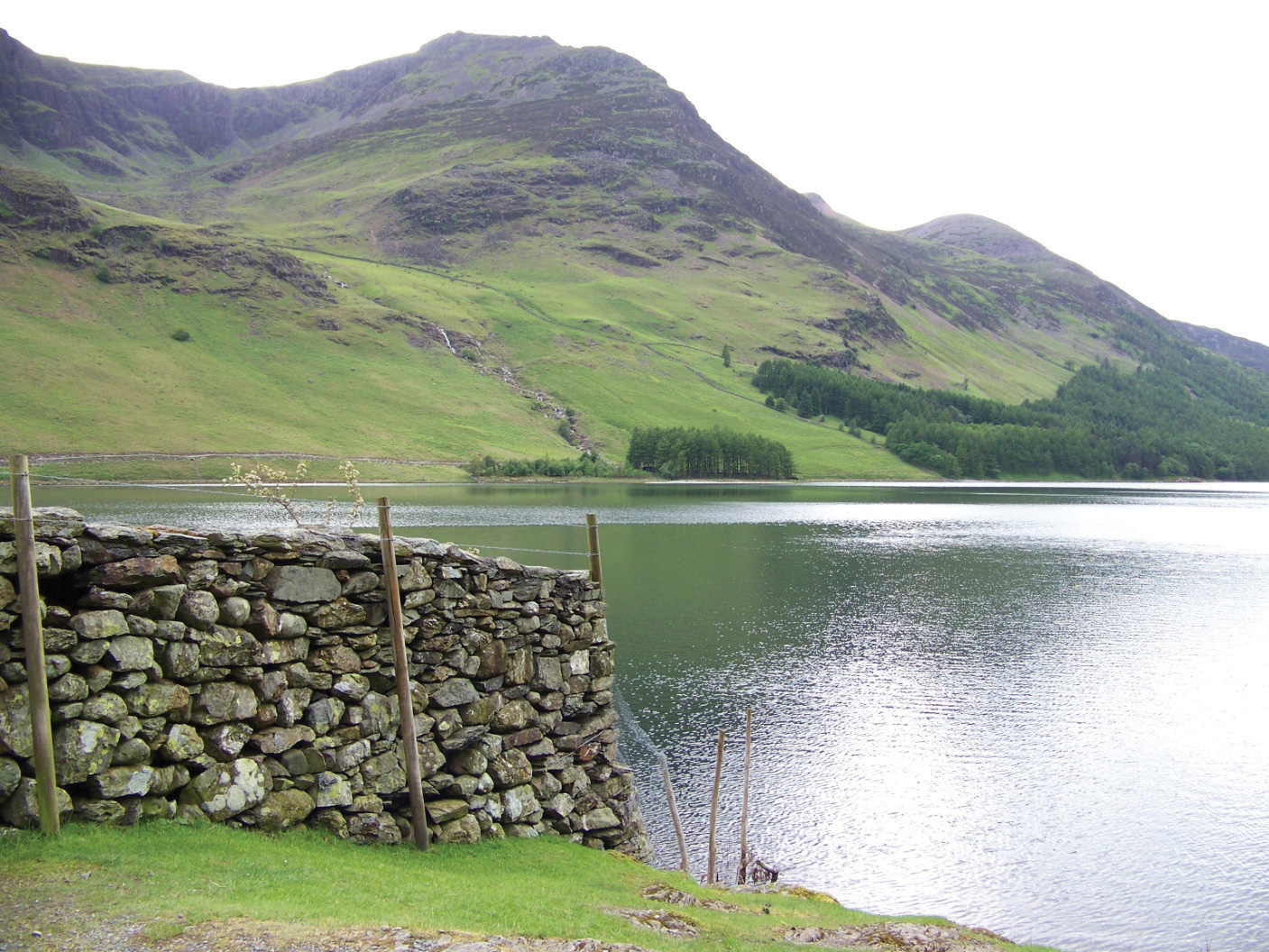
6.8 Samuel Taylor Coleridge (1772–1834)
PLEASE NOTE: This book is currently in draft form; material is not final.
Learning Objectives
- Explain the Romantic characteristic of mysticism and Coleridge's theory of the Imagination as they function in "The Eolian Harp."
- Understand how Coleridge's presentation of mysticism in "The Eolian Harp" plays out in narrative form in "The Rime of the Ancient Mariner."
- Assess the gothic elements in "The Rime of the Ancient Mariner."
- Recognize and explain the pattern of observation of nature leading to a meditation in "The Eolian Harp" and "This Lime-tree Bower, My Prison."
Biography
Samuel Taylor Coleridge was born in a small village in southwestern England. The son of a clergyman/school teacher, Coleridge attended his father's school. He learned to read very early and remained a voracious reader. After his father's death, Coleridge was sent to school in London where he met Charles Lamb, the friend to whom he wrote "This Lime-tree Bower My Prison." An excellent scholar, Coleridge attended Cambridge University but never finished a degree. He did, however, become enthralled with radical ideas such as communal living and with fellow poet Robert Southey planned to move to America to establish a utopian community called Pantisocracy, literally meaning equal government by all. The scheme required the participants to be married couples, so Coleridge married Sara Fricker, the sister of Southey's fiancée. Having married more for convenience than love, Coleridge was unhappy in his marriage, as presumably was his wife, and the two eventually separated.
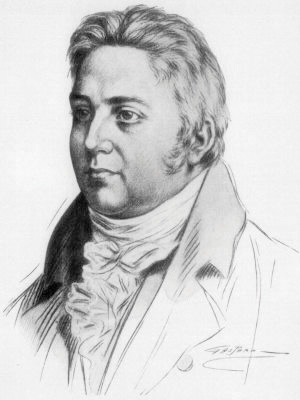
Coleridge and his wife Sara lived for a short time in Nether Stowey, a village near the Bristol Channel. Coleridge had met William Wordsworth who lived nearby at Alfoxden with his sister Dorothy Wordsworth. While living here, Coleridge produced some of his finest poetry, including "The Rime of the Ancient Mariner" and "This Lime-tree Bower My Prison."
Throughout his life Coleridge suffered from poor health and probably from poor mental health as well. By the early 1800's he had become addicted to opium. His addiction became so severe that he moved in with a doctor in London who helped him keep his drug use under control.
In his later years, Coleridge delivered a highly successful series of lectures on Shakespeare, wrote respected works of literary theory and criticism, and developed a reputation as an intellectual.
"The Eolian Harp"
This poem follows the pattern of observation of nature leading to a meditation. Notice the descriptive details of the cot [cottage] and its peaceful natural surroundings. Coleridge uses images of sound and smell as well as sight to help his audience imagine the scene he describes.
The Eolian Harp
(Composed at Clevedon, Somersetshire)
| My pensive Sara! thy soft cheek reclined | |
| Thus on mine arm, most soothing sweet it is | |
| To sit beside our Cot, our Cot o'ergrown | |
| With white-flower'd Jasmin, and the broad-leav'd Myrtle, | |
| (Meet emblems they of Innocence and Love!) | 5 |
| And watch the clouds, that late were rich with light, | |
| Slow saddening round, and mark the star of eve | |
| Serenely brilliant (such should Wisdom be) | |
| Shine opposite! How exquisite the scents | |
| Snatch'd from yon bean-field! and the world so hushed! | 10 |
| The stilly murmur of the distant Sea | |
| Tells us of silence. | |
| And that simplest Lute, | |
| Placed length-ways in the clasping casement, hark! | |
| How by the desultory breeze caress'd, | 15 |
| Like some coy maid half yielding to her lover, | |
| It pours such sweet upbraiding, as must needs | |
| Tempt to repeat the wrong! And now, its strings | |
| Boldlier swept, the long sequacious notes | |
| Over delicious surges sink and rise, | 20 |
| Such a soft floating witchery of sound | |
| As twilight Elfins make, when they at eve | |
| Voyage on gentle gales from Fairy-Land, | |
| Where Melodies round honey-dripping flowers, | |
| Footless and wild, like birds of Paradise, | 25 |
| Nor pause, nor perch, hovering on untam'd wing! | |
| O! the one Life within us and abroad, | |
| Which meets all motion and becomes its soul, | |
| A light in sound, a sound-like power in light, | |
| Rhythm in all thought, and joyance every where— | 30 |
| Methinks, it should have been impossible | |
| Not to love all things in a world so fill'd; | |
| Where the breeze warbles, and the mute still air | |
| Is Music slumbering on her instrument. | |
| And thus, my Love! as on the midway slope | 35 |
| Of yonder hill I stretch my limbs at noon, | |
| Whilst through my half-clos'd eye-lids I behold | |
| The sunbeams dance, like diamonds, on the main. | |
| And tranquil muse upon tranquillity; | |
| Full many a thought uncall'd and undetain'd, | 40 |
| And many idle flitting phantasies, | |
| Traverse my indolent and passive brain, | |
| As wild and various as the random gales | |
| That swell and flutter on this subject Lute! | |
| And what if all of animated nature | 45 |
| Be but organic Harps diversely fram'd, | |
| That tremble into thought, as o'er them sweeps | |
| Plastic and vast, one intellectual breeze, | |
| At once the Soul of each, and God of all? | |
| But thy more serious eye a mild reproof | 50 |
| Darts, O belovéd Woman! nor such thoughts | |
| Dim and unhallow'd dost thou not reject, | |
| And biddest me walk humbly with my God. | |
| Meek Daughter in the family of Christ! | |
| Well hast thou said and holily disprais'd | 55 |
| These shapings of the unregenerate mind; | |
| Bubbles that glitter as they rise and break | |
| On vain Philosophy's aye-babbling spring. | |
| For never guiltless may I speak of him, | |
| The Incomprehensible! save when with awe | 60 |
| I praise him, and with Faith that inly feels; | |
| Who with his saving mercies healéd me, | |
| A sinful and most miserable man, | |
| Wilder'd and dark, and gave me to possess | |
| Peace, and this Cot, and thee, heart-honour'd Maid! |
At the beginning of stanza 2 (line 13), Coleridge focuses attention on the lute (another word for the eolian harp—also sometimes spelled "aeolian") that sits in the window.
In stanza 2 Coleridge writes a fundamental statement of Romantic mysticism. The speaker exclaims, "O! the one Life within us and abroad." Here he recognizes, as Wordsworth did in "Tintern Abbey," the spiritual presence (the "one Life") that is "within us" (inside human beings) and "abroad" (in the things around us—in nature).
In stanza 4 Coleridge creates one of the central images of Romantic poetry. His speaker asks, "What if all of animated [living] nature be but organic Harps.…" All of living nature, including people, is compared to harps. He notes that the harps are "diversely framed"; people don't look alike just as all harps do not look alike. As the wind blows over the harp and enlivens the strings to create music, the spiritual presence that is in the world moves over people and enlivens their Imaginations. See lines 47 and 48.
Rather than ending the poem with the meditation section of stanzas 2–4, Coleridge adds a concluding stanza that takes the audience back to the cottage setting, thus framing the poem. After indulging in his intellectual, philosophical musings, his wife Sara brings him back down to earth. The last stanza specifically refers to God and to Christ, revealing of Christian religious beliefs. In this poem, Coleridge identifies the spiritual presence of Romantic mysticism as God.
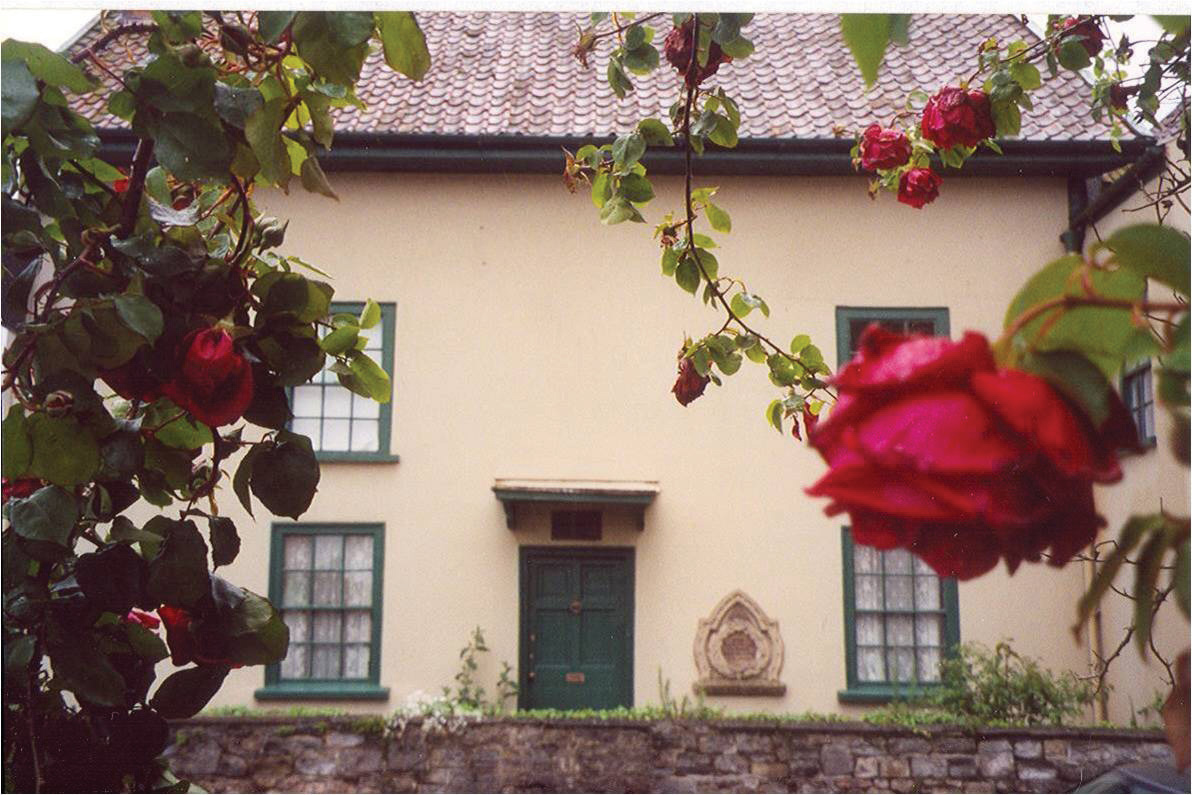
Coleridge's cottage at Nether Stowey.
"The Rime of the Ancient Mariner"
Coleridge's long narrative poem in ballad style, "The Rime of the Ancient Mariner," proved to be one of the more popular works in Lyrical Ballads. In this poem Coleridge takes an idea he proposes in theoretical form in "The Eolian Harp" and plays out the idea in a story. Having described the world of nature infused with a spiritual presence, the "one Life within us and abroad," Coleridge states in "The Eolian Harp" lines 31 and 32:
Methinks, it should have been impossible Not to love all things in a world so fill'd;
In the story of the Ancient Mariner we learn what happens to a person, the Mariner, who does not "love all things in a world" filled with a divine presence.
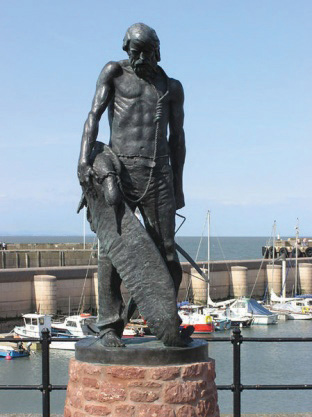
Modern statue of the Ancient Mariner with the albatross around his neck.
From one perspective, "The Rime of the Ancient Mariner" is an adventure story with gothic elements: supernatural events, the spirits, reanimated bodies, the Mariner's mystical abilities. From another perspective, it's the story of a man who had to learn to respect the spiritual presence in nature, the "one Life within us and abroad."
"This Lime-tree Bower My Prison"
Video Clip 6
Samuel Taylor Coleridge This Lime Tree Bower, My Prison.wmv
(click to see video)
View a video mini-lecture on "This Lime-tree Bower My Prison."
In the autobiographical and intimate "This Lime-tree Bower My Prison," Coleridge writes about the experience of sitting, unwillingly, beneath a tree's overspreading branches, feeling as if the branches form a room, a bower. Because he didn't want to be there, he characterizes the bower as a prison. Coleridge's wife had accidently spilled boiling milk on his foot, and because of his injury he was unable to accompany his friends, including Charles Lamb, on a hike. Coleridge particularly wanted his friend Lamb, who lived in London, to experience nature. The complaining, grumbling tone comes through in the first two lines of the poem:
Well, they are gone, and here must I remain, This lime-tree bower my prison! Well, they are gone, and here must I remain, This lime-tree bower my prison! Well, they are gone, and here must I remain, This lime-tree bower my prison! Well, they are gone, and here must I remain, This lime-tree bower my prison!
In lines 2–5, Coleridge explains why he is so upset about missing the hike:
I have lost Beauties and feelings, such as would have been Most sweet to my remembrance even when age Had dimm'd mine eyes to blindness!
This idea is very similar to Wordsworth's explanation of gathering "life and food for future years" in "Lines Composed a Few Miles Above Tintern Abbey."
Although Coleridge complains about missing the walk, in stanza 3 he finds a consolation: he's found nature in his "bower." He realizes he can see the beauty of nature where he sits. He learns that "nature ne'er deserts the wise and pure." Again he echoes a line from Wordsworth's "Lines": "Nature never did betray / The heart that loved her."
Key Takeaways
- "The Eolian Harp" and "This Lime-tree Bower, My Prison" use the typical Romantic structure of an observation of nature leading to a meditation.
- Coleridge fashions a key image of Romantic mysticism in "The Eolian Harp."
- "The Rime of the Ancient Mariner" illustrates the theoretical statements of "The Eolian Harp" by narrating what happens to one individual who fails to recognize and appreciate the spiritual presence in nature.
- "The Rime of the Ancient Mariner," one of the most popular poems in Lyrical Ballads, exhibits gothic elements.
- Similar to Wordsworth's desire to share the spiritual blessings of nature with his sister expressed in "Lines Composed a Few Miles Above Tintern Abbey," Coleridge wishes to share the experience with his friend and fellow writer Charles Lamb.
Exercises
-
In his Biographia Literaria, Coleridge explains his theory of the Imagination:
The Imagination then I consider either as primary, or secondary. The primary Imagination I hold to be the living Power and prime Agent of all human Perception, and as a repetition in the finite mind of the eternal act of creation in the infinite I Am. The secondary I consider as an echo of the former, co-existing with the conscious will, yet still as identical with the primary in the kind of its agency, and differing only in degree, and in the mode of its operation.
For Coleridge, Imagination is a creative process that mirrors the creation of the universe. He compares the wind (blowing across the harp to create music) with an act of Imagination.
The word inspire literally means to breathe into. How does the word inspire relate to Coleridge's description of the eolian harp and to Coleridge's idea of the Imagination?
- Coleridge's "The Rime of the Ancient Mariner" is written in seven parts. Write a brief (2 or 3 sentence) plot summary of each part.
- "The Rime of the Ancient Mariner" was published in the 1798 Lyrical Ballads. Working jointly on the volume, Wordsworth and Coleridge collaborated closely on some parts of this poem. Part of Coleridge's "assignment" in producing the volume was to write poems that included supernatural elements, and "Ancient Mariner" abounds with supernatural elements. List several.
- The Ancient Mariner himself has supernatural abilities; he holds the wedding guest with his "glittering eye" (line 13). The Ancient Mariner uses this magical ability to force someone to stay and listen to his story with some people, but not others. How does he determine to whom to tell his story? See Part 7.
- Why did the Ancient Mariner shoot the albatross, and why was his shooting the bird such a heinous act? Think about Romantic mysticism in answering this question.
- The last four stanzas of Part 4 are the climactic moment in the story. What change in attitude does the Ancient Mariner experience that finally allows his punishment out on the sea to end?
- When the spirits leave the bodies of the Mariner's shipmates, to what does Coleridge compare the sound? Why does he choose this particular simile?
- The Ancient Mariner's punishment, of course, is not completely over. What penance does he have to pay for the rest of his life?
Resources
The Aeolian Harp
- The Aeolian Harp. Charles Rzepka. Boston University. explanation and images of aeolian harps.
- "Aeolian Vibration." John H. Lienhard. University of Houston. Engines of Our Ingenuity. audio and text.
6.9 Jane Austen (1775–1817)
PLEASE NOTE: This book is currently in draft form; material is not final.
In her novels, Jane Austen fashions the quintessential picture of Regency England, the period from 1811–1820 in which Prince George served as Prince Regent to his father King George III. Bouts of insanity, now believed to have been caused by an illness and made worse by physicians and virtual imprisonment, made George III incapable of ruling, leading to the regency of his son and heir apparent, George, later to become King George IV on his father's death. This era, dominated by the French Revolution, the Napoleonic Wars, and the Industrial Revolution, juxtaposed world-changing political events and technological innovations with the ostentatious, consciously fashionable world of the Prince Regent and the aristocracy bound by strict rules of social behavior. The aristocracy viewed manners, living according to society's strictures, as indicative of belonging to the coterie in a time when being ostracized by society was considered a fate worse than death. The title of Jane Austen's first published novel, Sense and Sensibility, suggests an age influenced by 18th-century rationalism and 19th-century Romanticism.
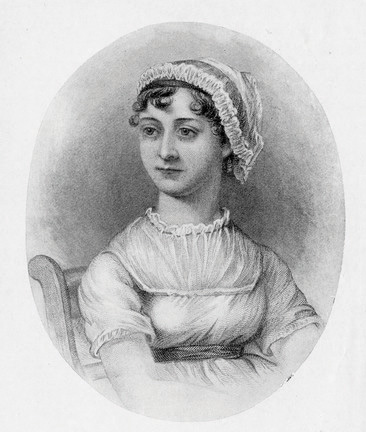
Biography
Jane Austen spent her childhood in the village of Steventon, where her father was the rector and her family active in village social life. The seventh of eight children, Jane was particularly close to her only sister Cassandra throughout her life. Although she began writing in childhood, her first novel was not published until 1811. Austen apparently fell in love with a young man, Tom LeFroy, who visited the neighborhood for a time, but whose family sent for him to return home to Ireland when they became aware of his interest in Austen, the daughter of a poor, low-ranking clergyman. Her sister Cassandra was engaged to a man who died while on business in the Caribbean, and neither sister ever married.
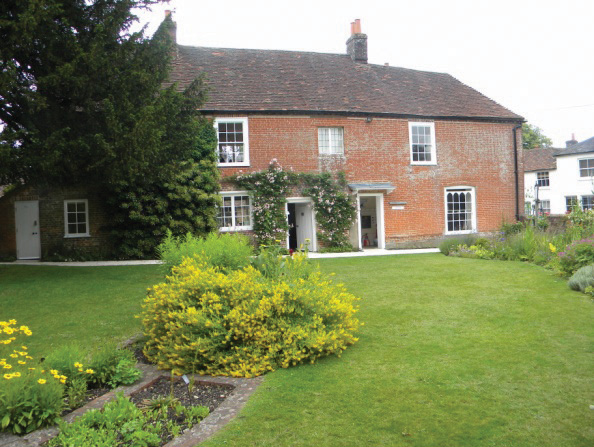
Jane Austen's home in Chawton.
After her father's retirement, Austen moved with her family to Bath, a setting used in her novels. When her father died, the Austen sisters and their mother were financially dependent on Austen's brothers. They lived for a time in Southampton with her brother Frank, a naval officer, and his wife and spent a good bit of their time traveling from relative to relative, a situation not uncommon for widows and spinsters in the early 19th century. Finally another brother, Edward, offered his mother and sisters the use of a house on his estate in Chawton. While living here Austen published four novels:
- Sense and Sensibility 1811
- Pride and Prejudice 1813
- Mansfield Park 1814
- Emma 1816
Two novels were published posthumously:
- Northanger Abbey 1818
- Persuasion 1818
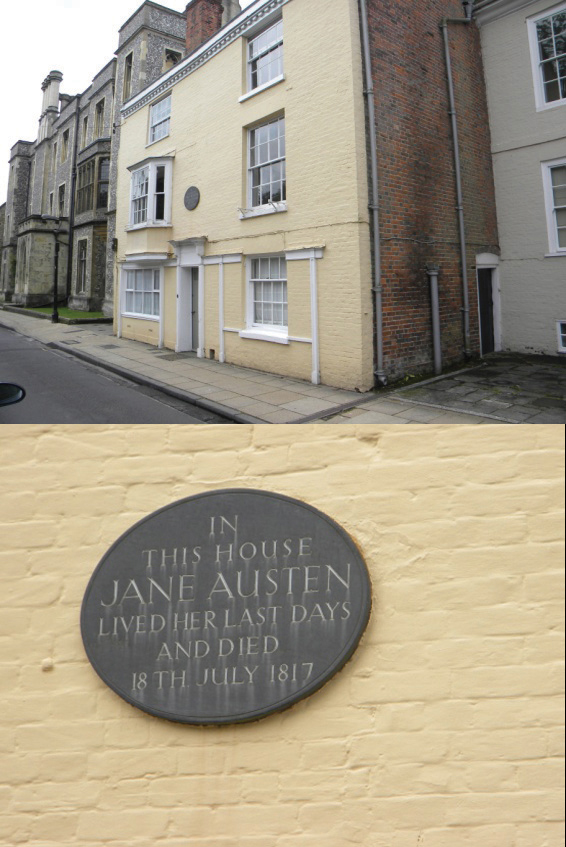
When Austen's health began to fail, Cassandra moved with her to nearby Winchester, a larger city where medical help would be available. Austen died soon after the move and was buried in Winchester Cathedral.
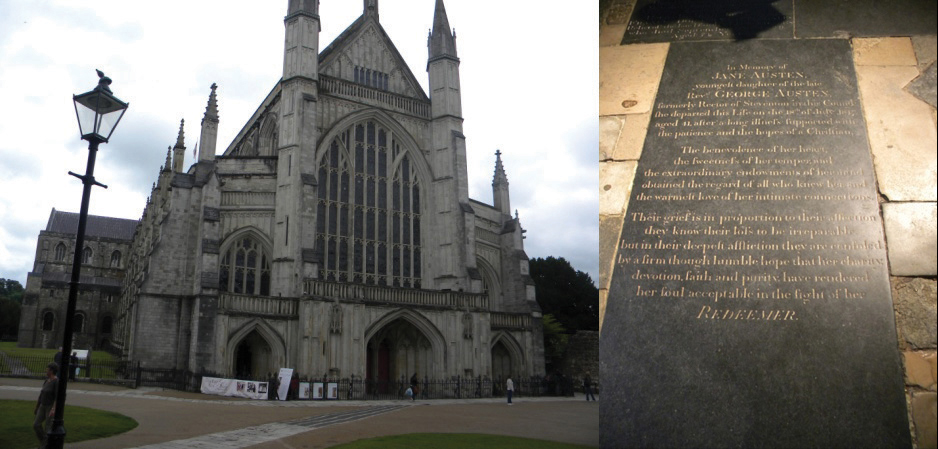
Pride and Prejudice
Jane Austen's works are novels of mannersNovels that portray and assess the values, customs, and behavior of a particular social stratum at a specific time in history. , novels that portray and assess the values, customs, and behavior of a particular social stratum at a specific time in history. Indeed, one of the typical criticisms of Austen's work is that her focus is an especially small segment of Regency society, the lower rung of landed gentry to which her own family belonged.
The Title
An early version of Pride and Prejudice was titled First Impressions, referring to the first impressions Elizabeth Bennett and Fitzwilliam Darcy have of each other. Although the same concept applies in the published title, the first impressions are named and set the tone for the novel.
The Characters
Although the Bennets, on the surface, seem ruled by the mores of their society, the story proves that most of the family ill fit the expectations society would have for them. Mr. Bennet cares too little for society and too much for scholarly pursuits, preferring to simply withdraw from the societal pressures that are his wife's obsession. Although he is an immensely likable character, he lacks the leadership that might have averted some the family's difficulties. Mrs. Bennet, on the other hand, is so concerned with appearances and making what society would deem appropriate arrangements for her daughters' futures that she becomes almost a caricature of a society mother. Yet she apparently is much more aware of the reality of the family's financial situation than Mr. Bennet.
Lady Catherine de Bourgh shares Mrs. Bennet's esteem for society's rules, but their characters are quite different, Lady Catherine a stereotype of the society matron and Mrs. Bennet of the foolish, pushy woman unable to see her own inappropriate behavior. Elizabeth and Lydia, too, could be seen as similar in their disregard for society's conventions and yet with opposite results. Even Wickham cannot be seen as a totally evil character as his childhood circumstances may give him a sympathetic slant, especially to modern readers.
Key Takeaways
- Jane Austen's Pride and Prejudice is a novel of manners focused on the life of lower ranking gentry in a small English village.
- Pride and Prejudice portrays characters caught between the expectations of their society and their personal desires.
- Some characters in Pride and Prejudice appear to deal with realistic dilemmas while others seems to be stereotypes of Regency society; none, however, are one dimensional as all characters realistically possess virtues and flaws.
Exercises
- How would the women of the Bennet family fit into Mary Wollstonecraft's description of women in the late 18th, early 19th centuries?
- What expectations of society color the initial relationship between Elizabeth and Darcy? Do these expectations become more or less important as their relationship progresses? Explain how the title applies to their relationship at the beginning and throughout the novel.
- Compare and contrast the match of Jane and Bingley and that of Elizabeth and Darcy. Is one match more appropriate than the other? Why or why not?
- Elizabeth and Lydia both, in different ways, flaunt the expectations of society in their behavior and make marriages that society would deem inappropriate, yet readers (and most of the other characters) thoroughly approve of one and disapprove of the other. Why?
- How would you describe Elizabeth's reaction to and feelings about Charlotte's marriage to Mr. Collins?
- Analyze each of the major characters in the novel, making a list of assets and flaws.
- How accurate would you consider Austen's portrayal of this segment of society?
- What circumstances in Jane Austen's life might be seen as parallel with life in the novel?
Resources
Video
- Jane Austen. Dr. Carol Lowe, McLennan Community College.
6.10 George Gordon, Lord Byron (1788–1924)
PLEASE NOTE: This book is currently in draft form; material is not final.
Learning Objectives
- Define and provide examples of the character type known as the Byronic hero.
- Appraise the characteristics of Romanticism apparent in Byron's poetry, and compare and contrast their use in the poetry of Wordsworth and Coleridge.
- Recognize and interpret the theme of the aspiring spirit in Byron's poetry.
Biography
"Mad, bad, and dangerous to know" is the infamous assessment of Lord Byron by Lady Caroline Lamb, herself a scandalous figure among the elite circles of early 19th-century aristocratic society.
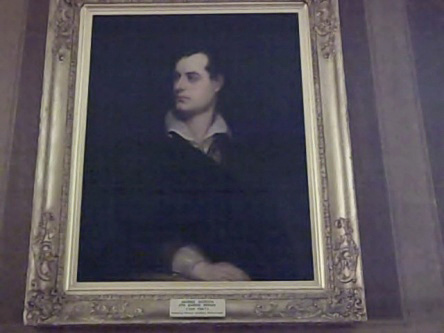
Portrait of Byron at Newstead Abbey.
Byron inherited the rank of Baron after his father and his uncle died. Unfortunately, they had squandered the family fortune. Byron enjoyed noble rank but lacked the wealth necessary to maintain the lifestyle he believed should accompany it. He also inherited Newstead Abbey, the family estate, in disrepair, and could not afford to repair or even heat it.
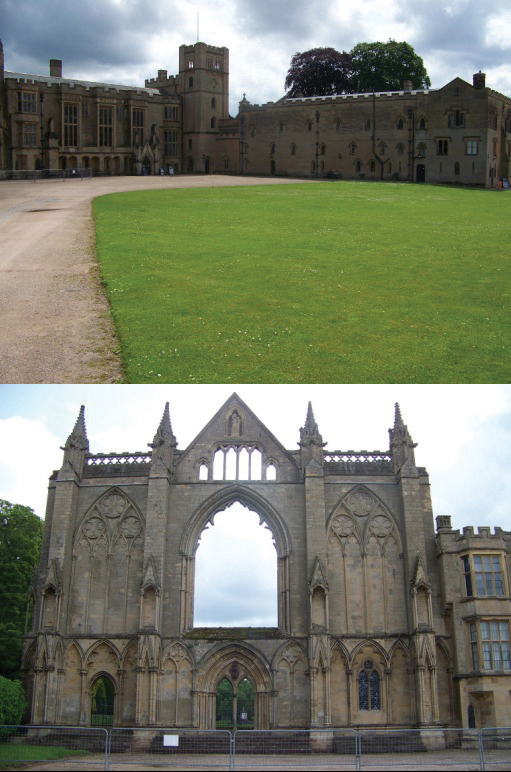
Newstead Abbey, Byron's ancestral home.
The ruins of the original abbey granted to Byron's ancestors by Henry VIII.
Byron suffered from a malformed foot which caused him to limp badly, a source of embarrassment and indignity to him both in his childhood and as an adult. He formed close friendships with other young noblemen at Trinity College, Cambridge. While at Cambridge, Byron began to accumulate the gambling debts that would plague him all his life, eventually causing him to sell Newstead Abbey, the estate granted to his family six generations earlier by King Henry VIII. He also cultivated the reputation for perverted sexual promiscuity that characterized his public persona for the rest of his life, deserved according to some biographers, undeserved according to others. While at Cambridge, Byron published his first books of poetry.
Traditionally young men of Byron's station undertook a Grand Tour of Europe after their graduation from college. Accompanied by a friend, Byron borrowed money to travel to Portugal, Albania, Turkey, Greece, and Italy. During this trip, Byron wrote the first two Cantos of Childe Harold's Pilgrimage. Their publication brought him overnight fame, the kind of adulation that has been compared to that of a modern rock star.
Childe Harold was a character closely identified with Byron himself, the Byronic heroA dark, brooding figure, jaded and cynical, bored with and contemptuous of conventional society. , a dark, brooding figure, jaded and cynical, bored with and contemptuous of conventional society. Byron continued to write long narrative poems featuring this type of character (The Giaour, The Bride of Abydos, The Corsair, Manfred) and at the same time continued to cultivate his own public anti-hero persona.
One of his most notorious escapades involved a love affair with the married Lady Caroline Lamb, a prominent member of the aristocracy who continued to pursue Byron publicly even after he tried to end the affair.
As an adult, Byron met and became close to his half-sister Augusta Leigh. Some biographers believe that he had an incestuous affair with her and that her daughter was Byron's child.
Byron married Annabella Milbanke, a conventional young woman from a wealthy family. She lived with Byron until their daughter was born and then left him, unable to contend with his increasingly bizarre behavior. Some of Byron's associates feared that he was insane when he fired his pistols in his house, abused his wife, and continued his scandalous sexual escapades. His wife left him, taking their daughter, obtained a divorce (virtually unheard of at that time), and returned to her family.
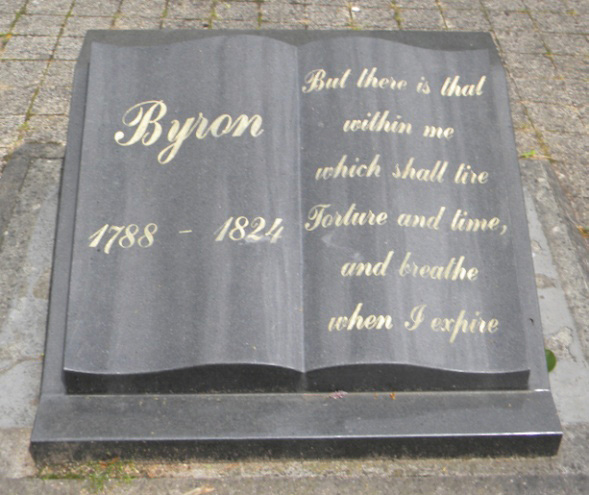
Memorial outside Byron's burial place in Hucknall Church.
Realizing that the public was no longer fascinated but revolted by his behavior, Byron left England, never to return. Traveling first to Switzerland, Byron lived for a time near the poet Shelley and his then-companion, later wife Mary Wollstonecraft Godwin and her sister Claire Clairmont with whom Byron had another daughter. Moving to Italy, Byron had a long-standing affair with a married Italian noblewoman. During these travels he wrote Cantos 3 and 4 of Childe Harold's Pilgrimage and began what would be considered his greatest work, the satiric Don Juan.
Moving to Greece, Byron, even though he had no military expertise, became involved in the Greek fight for independence from the Ottoman Empire. While with the Greek forces, Byron contracted a fever and died. His body was returned to England but refused burial in Westminster Abbey because of his reputed immorality. He eventually was buried in a small church near his family's former estate Newstead Abbey. Not until 1969 was a plaque honoring Byron placed in Westminster Abbey's Poet's Corner.
Texts
- Childe Harold's Pilgrimage. Project Gutenberg.
- "The Prisoner of Chillon." Representative Poetry Online. Ian Lanchashire. Department of English, University of Toronto. University of Toronto Libraries.
- "She Walks in Beauty." Representative Poetry Online. Ian Lanchashire. Department of English, University of Toronto. University of Toronto Libraries.
- "When We Two Parted." Bartleby.com. rpt. from English Poetry II: From Collins to Fitzgerald. The Harvard Classics. 1909–14.
- Works of Byron. The International Byron Society.
- The Works of Lord Byron. Ed. Ernest Hartley Coleridge and R. E. Prothero. University of Virginia Library.
Childe Harold's Pilgrimage
After the publication of the first two Cantos of Childe Harold's Pilgrimage, Byron declared that he awoke one morning to find himself famous.
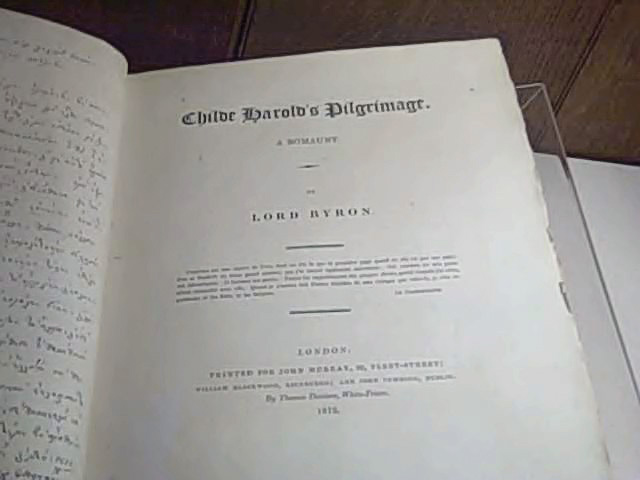
First edition of Childe Harold's Pilgrimage in the library of Newstead Abbey.
The term childeA medieval expression referring to a young man in training to become a knight. is a medieval expression referring to a young man in training to become a knight. Canto 1 begins with a description of a young man, Childe Harold, in England ("Albion's isle") who is living a riotous, shameful life. He discovers he is satiated with his dissipated ways and sets out on a pilgrimage to discover some meaning in life.
The poem, and Childe Harold, reach a pivotal moment in the Canto 3 stanzas about Lake Leman in Switzerland. Although Byron writes about nature in this section, his poetry generally displays little of the preoccupation with nature seen in other Romantic writers.
His focus instead is man's aspiring spirit. Nature is beautiful and peaceful compared with a world inhabited by humans driven by their aspiring spirits and indomitable wills.
Canto 3 from "Childe Harold's Pilgrimage"
Stanza 85
Clear, placid Leman! thy contrasted lake, With the wild world I dwelt in, is a thing Which warns me, with its stillness, to forsake Earth's troubled waters for a purer spring. This quiet sail is as a noiseless wing To waft me from distraction; once I loved Torn Ocean's roar, but thy soft murmuring Sounds sweet as if a Sister's voice reproved, That I with stern delights should e'er have been so moved. *****
Stanza 88
Ye Stars! which are the poetry of Heaven! If in your bright leaves we would read the fate Of men and empires,—'tis to be forgiven, That in our aspirations to be great, Our destinies o'erleap their mortal state, And claim a kindred with you; for ye are A Beauty and a Mystery, and create In us such love and reverence from afar, That Fortune,—Fame,—Power,—Life, have named themselves a Star.
Following a description of an overnight storm in which the speaker's spirit soars and longs to express its "Soul, heart, mind, passions, feelings" (Stanza 97) as strongly and vividly as nature expresses itself in the storm, morning arrives with suggestions of the human spirit calm and refreshed after the storm of struggle.
Canto 3 from "Childe Harold's Pilgrimage"
Stanza 98
The Morn is up again, the dewy Morn, With breath all incense, and with cheek all bloom— Laughing the clouds away with playful scorn, And living as if earth contained no tomb,— And glowing into day: we may resume The march of our existence: and thus I, Still on thy shores, fair Leman! may find room And food for meditation, nor pass by Much, that may give us pause, if pondered fittingly.
Although line 8 of stanza 98 seems to echo Wordsworth's claim that nature provides "life and food for future years," Byron provides no hints of Wordsworth's view of nature as divine revelation or a veil discreetly disclosing a spiritual presence. Nonetheless, nature is a source of wisdom and meditation.
"She Walks in Beauty Like the Night" and "When We Two Parted"
She Walks in Beauty
She walks in beauty—like the night Of cloudless climes and starry skies, And all that's best of dark and bright Meet in her aspect and her eyes; Thus mellowed to the tender light Which heaven to gaudy day denies. One shade the more, one ray the less, Had half impaired the nameless grace Which waves in every raven tress Or softly lightens o'er her face— Where thoughts serenely sweet express How pure, how dear their dwelling place. And on that cheek and o'er that brow So soft, so calm yet eloquent, The smiles that win, the tints that glow But tell of days in goodness spent A mind at peace with all below, A heart whose love is innocent.
This simple, eloquent lyric is said to have been written when Byron met a cousin who was wearing a black mourning dress covered in spangles. The speaker describes the woman in tender phrases which combine images of darkness and light.
When We Two Parted
When we two parted In silence and tears, Half broken-hearted To sever for years, Pale grew thy cheek and cold, Colder thy kiss; Truly that hour foretold Sorrow to this. The dew of the morning Sunk chill on my brow— It felt like the warning Of what I feel now. Thy vows are all broken, And light is thy fame: I hear thy name spoken, And share in its shame. They name thee before me, A knell to mine ear; A shudder comes o'er me— Why wert thou so dear? They know not I knew thee, Who knew thee too well: Long, long shall I rue thee, Too deeply to tell. In secret we met— In silence I grieve, That thy heart could forget, Thy spirit deceive. If I should meet thee After long years, How should I greet thee? With silence and tears.
Like "She Walks in Beauty," this lyric expresses deep emotion in simple and eloquent terms.
"The Prisoner of Chillon"
While staying with Shelley in Switzerland, Byron toured the Castle of Chillon on Lake Geneva (Lake Leman), including the dungeon he describes in this narrative poem. Byron's name can still be seen carved on one of the pillars in the dungeon.
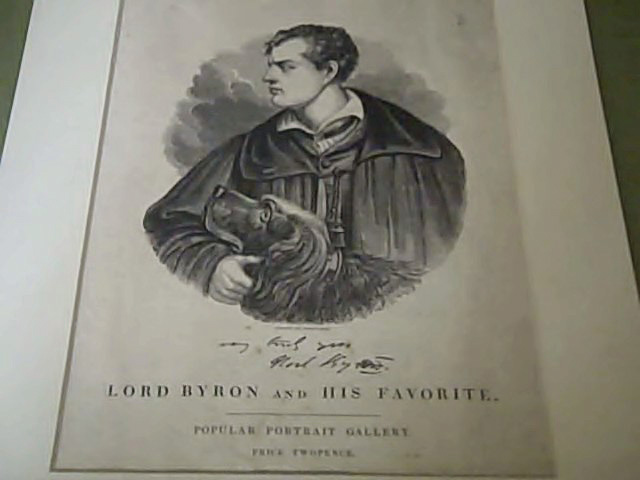
Portrait of Byron and his favorite dog in the library of Newstead Abbey.
One of the characteristics of Romanticism is an interest in the medieval past, and Byron loosely bases his story on the life of Francois Bonivard from the early 16th century. He imbues his story with one of his recurrent themes—the indomitable will of the human spirit.
Key Takeaways
- George Gordon, Lord Byron created the Byronic hero, a dark, brooding figure, jaded and cynical, bored with and contemptuous of conventional society
- Although in a different context than the poetry of Wordsworth and Coleridge, nature plays a significant role in Byron's poetry.
- Other characteristics of Romanticism are apparent in Byron's poetry.
- The aspiring spirit is a key theme in Byron's poetry.
Exercises
-
Stanzas 85 through 98 in Childe Harold's Pilgrimage are considered a climactic point in the poem. After reading these stanzas answer the following questions:
- What might Lake Leman represent in the speaker's life?
- How does the speaker compare the natural world and the world inhabited by people?
- What do the stars represent in stanza 88?
- In stanza 90, what does the speaker mean when he says we are "least alone" in solitude?
- What does the storm symbolize? Refer to specific descriptions.
- How would you compare the use of nature in these stanzas with the use of nature in other Romantic poetry you have read?
- How would you compare the ideas in the last two lines of stanza 98 with ideas from Wordsworth's "Lines Composed a Few Miles Above Tintern Abbey" and Coleridge's "This Lime-tree Bower My Prison"?
- In "She Walks in Beauty" how does the speaker equate physical beauty with beauty of character?
- What has happened in "When We Two Parted"?
- In the last stanza of "When We Two Parted" it's clear that the speaker still remembers his lost love, but does the woman remember him? How do we know? Describe the speaker's reaction when the two meet years later.
- Describe the narrator of "The Prisoner of Chillon."
- What happens in stanza 10 of "The Prisoner of Chillon" and how does it change the narrator?
- How would you compare the use of nature in "The Prisoner of Chillon" with nature in the work of other Romantic writers?
- Describe the narrator's reaction to being liberated at the end of the story.
Resources
General Information
- "Romantic Anger and Byron's Curse." Andrew M. Stauffer, University of Virginia. Praxis Series. Ed. Orrin N.C. Wang. Romantic Circles. General Editors, Neil Fraistat and Steven E. Jones. Technical Editor, Laura Mandell. University of Maryland.
Texts
- Childe Harold's Pilgrimage. Project Gutenberg.
- "The Prisoner of Chillon." Representative Poetry Online. Ian Lanchashire. Department of English, University of Toronto. University of Toronto Libraries.
- "She Walks in Beauty." Representative Poetry Online. Ian Lanchashire. Department of English, University of Toronto. University of Toronto Libraries.
- "When We Two Parted." Bartleby.com. rpt. from English Poetry II: From Collins to Fitzgerald. The Harvard Classics. 1909–14.
- Works of Byron. The International Byron Society.
- The Works of Lord Byron. Ed. Ernest Hartley Coleridge and R. E. Prothero. University of Virginia Library.
6.11 Percy Bysshe Shelley (1792–1822)
PLEASE NOTE: This book is currently in draft form; material is not final.
"Life, like a dome of many coloured glass / Stains the white radiance of eternity."
from Adonais
Learning Objectives
- Identify in "Mont Blanc" and "To a Skylark" the typical pattern found in Romantic poetry: observation of nature leading to a meditation.
- Compare Romantic mysticism in Shelley's poetry with mysticism in the works of other Romantic writers.
- Analyze the role of nature in Shelley's poetry.
- Recognize and explain the use of other characteristics of Romanticism in Shelley's poetry.
- Trace the political events that led Shelley to write "Song to the Men of England."
Biography
Percy Bysshe Shelley, the son of a Member of Parliament, enjoyed a happy childhood in the countryside of southern England. The rest of his life, however, proved to be less happy.
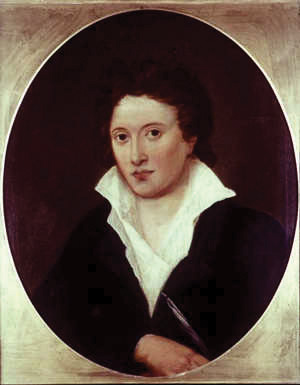
Portrait of Percy Bysshe Shelley by Curran, 1819.
While a student at Oxford, Shelley published his first poetry. He also published a pamphlet titled "The Necessity of Atheism" which resulted in his expulsion from Oxford University. Shelley's refusal to recant his objectionable religious views, a condition for his re-admittance to Oxford, caused a rift with his family.
On his own with no income and no employment, Shelley married 16-year-old Harriet Westbrooke, who would commit suicide only five years later after Shelley abandoned her and their children. Shelley and Westbrooke lived for a short time in the Lake District where Shelley met and was influenced by Wordsworth. Shelley soon fell in love with Mary Wollstonecraft Godwin, the daughter of William Godwin and Mary Wollstonecraft, and moved to Switzerland with her and her step-sister Claire Clairmont (who would later have a child with Byron). Shelley invited his wife Harriet to live with the trio in the role of a sister, an invitation she declined. When he received the news that Harriet, abandoned and pregnant by another man, had drowned herself in the Serpentine in Hyde Park, Shelley married Mary Godwin. During this turbulent period of his life, Shelley was poor and in debt. However, he continued to write, encouraged by his meeting and developing friendships with Byron and John Keats. One of Shelly's major works, Adonais, is an elegy to Keats.
Shelley's financial situation eventually improved on receipt of an inheritance from his grandfather; his personal life, in contrast, worsened. He lost custody of his children with Harriet on the grounds of his immoral lifestyle and his atheism. He, Mary, and Claire Clairmont then moved to Italy where his two young children with Mary Shelley died. The couple had a third son who survived his father. While sailing off the coast of Italy, Shelley was caught in a sudden storm and drowned. He was not yet thirty years old. His body was cremated on the beach after washing up on the shore and his ashes buried in the Protestant cemetery in Rome. A story claims that Edward Trelawny, a friend of both Shelley and Byron present when the body was cremated, reached into the fire to preserve Shelley's heart.
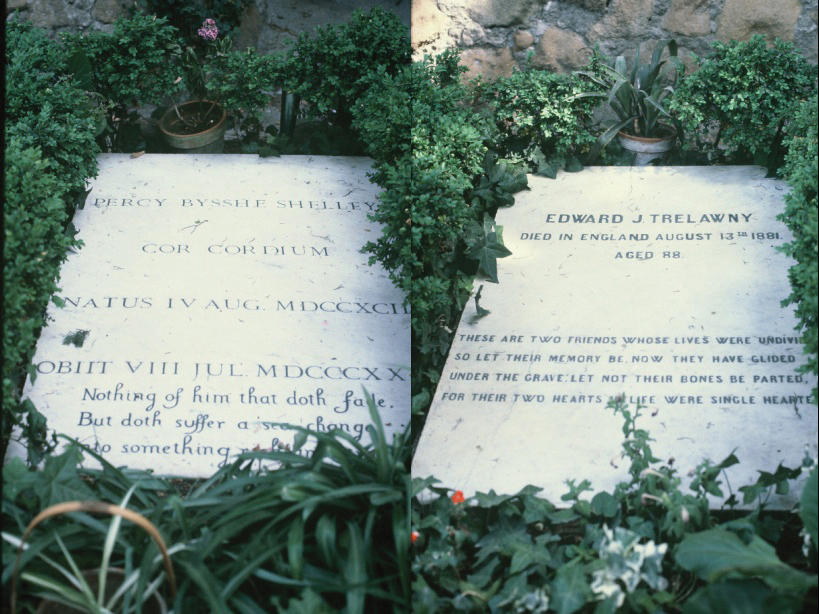
Shelley's ashes are buried in the Protestant Cemetery in Rome. His grave marker bears the inscription "Cor Cordium," meaning "heart of hearts." It's said that Mary Shelley kept Shelley's heart, pulled from the cremation flames by Trelawny, and that it eventually was buried with their only surviving child.
After Shelley's death, his friend Edward Trelawny returned to England and lived to age 88. As Shelley's work became more popular in the later 19th century, Trelawny was considered an expert on Shelley. When he died, he was buried next to Shelley in Rome.
Although Shelley's poetry was not well received or widely read during his lifetime (his radical views, particularly his professed atheism, and his unconventional lifestyle were distasteful to many early 19th-century readers), it became an important influence on later 19th- and early 20th-century writers.
"Mont Blanc"
Although more abstract in its construction, Shelley's "Mont Blanc" follows the typical Romantic pattern of an observation of nature leading to a meditation. While observing Mont Blanc, the highest mountain in the Alps, Shelley considers the relation between the physical universe—the world of nature—and the individual mind. This relationship is Shelley's expression of Romantic mysticism.
I
The everlasting universe of things Flows through the mind, and rolls its rapid waves, Now dark—now glittering—now reflecting gloom— Now lending splendour, where from secret springs The source of human thought its tribute brings Of waters—with a sound but half its own, Such as a feeble brook will oft assume, In the wild woods, among the mountains lone, Where waterfalls around it leap for ever, Where woods and winds contend, and a vast river Over its rocks ceaselessly bursts and raves.
Section 1: In the poetry of Wordsworth and Coleridge, mysticism is the perception of a spiritual presence in nature. Shelley, who professed to be an atheist, pictures the "spiritual" presence not as a divine presence, but as an intellectual power. Note the first two lines of "Mont Blanc": "The everlasting universe of things / Flows through the mind.…" It is the power of the mind—the intellect—that is the force evident in nature.
II
Thus thou, Ravine of Arve—dark, deep Ravine— Thou many-colour'd, many-voiced vale, Over whose pines, and crags, and caverns sail Fast cloud-shadows and sunbeams: awful scene, Where Power in likeness of the Arve comes down From the ice-gulfs that gird his secret throne, Bursting through these dark mountains like the flame Of lightning through the tempest;—thou dost lie, Thy giant brood of pines around thee clinging, Children of elder time, in whose devotion The chainless winds still come and ever came To drink their odours, and their mighty swinging To hear—an old and solemn harmony; Thine earthly rainbows stretch'd across the sweep Of the aethereal waterfall, whose veil Robes some unsculptur'd image; the strange sleep Which when the voices of the desert fail Wraps all in its own deep eternity; Thy caverns echoing to the Arve's commotion, A loud, lone sound no other sound can tame; Thou art pervaded with that ceaseless motion, Thou art the path of that unresting sound— Dizzy Ravine! and when I gaze on thee I seem as in a trance sublime and strange To muse on my own separate fantasy, My own, my human mind, which passively Now renders and receives fast influencings, Holding an unremitting interchange With the clear universe of things around; One legion of wild thoughts, whose wandering wings Now float above thy darkness, and now rest Where that or thou art no unbidden guest, In the still cave of the witch Poesy, Seeking among the shadows that pass by Ghosts of all things that are, some shade of thee, Some phantom, some faint image; till the breast From which they fled recalls them, thou art there!
Section 2: Shelley compares this intellectual force to the River Arve that flows down the mountain. In lines 15–16, the speaker says that, like the source of the Arve, the "Power"—the presence in nature—is "secret," unknown to humans. We can't see the source of the river, but that certainly doesn't mean we doubt the river's existence; likewise, we don't know the source, but we should not doubt the existence of the intellectual power in nature. When he gazes on the ravine, he feels compelled to "muse" upon his own human mind which both passively receives the information the senses provides and communicates with the "clear universe of things around."
III
Some say that gleams of a remoter world Visit the soul in sleep, that death is slumber, And that its shapes the busy thoughts outnumber Of those who wake and live.—I look on high; Has some unknown omnipotence unfurl'd The veil of life and death? or do I lie In dream, and does the mightier world of sleep Spread far around and inaccessibly Its circles? For the very spirit fails, Driven like a homeless cloud from steep to steep That vanishes among the viewless gales! Far, far above, piercing the infinite sky, Mont Blanc appears—still, snowy, and serene; Its subject mountains their unearthly forms Pile around it, ice and rock; broad vales between Of frozen floods, unfathomable deeps, Blue as the overhanging heaven, that spread And wind among the accumulated steeps; A desert peopled by the storms alone, Save when the eagle brings some hunter's bone, And the wolf tracks her there—how hideously Its shapes are heap'd around! rude, bare, and high, Ghastly, and scarr'd, and riven.—Is this the scene Where the old Earthquake-daemon taught her young Ruin? Were these their toys? or did a sea Of fire envelop once this silent snow? None can reply—all seems eternal now. The wilderness has a mysterious tongue Which teaches awful doubt, or faith so mild, So solemn, so serene, that man may be, But for such faith, with Nature reconcil'd; Thou hast a voice, great Mountain, to repeal Large codes of fraud and woe; not understood By all, but which the wise, and great, and good Interpret, or make felt, or deeply feel.
Section 3: Shelley claims that the "wilderness" [nature] can teach one either "doubt" or "faith." Perception of the Power may result in faith (like that of Wordsworth and Coleridge) which comes from the peaceful acceptance of God's presence in nature. An equally possible reaction is to develop "doubt" of any orthodox religious view that sees nature as God's handiwork. The mountain, though, has a voice to "repeal / Large codes of fraud and woe." Not all, however, can understand that voice. In an idea reminiscent of Wordsworth's claim that a poet is a "man speaking to men" but a man of greater sensibility, Shelley points out that the "wise, and great, and good" can interpret the mountain's voice.
IV
The fields, the lakes, the forests, and the streams, Ocean, and all the living things that dwell Within the daedal* earth; lightning, and rain, Earthquake, and fiery flood, and hurricane, The torpor of the year when feeble dreams Visit the hidden buds, or dreamless sleep Holds every future leaf and flower; the bound With which from that detested trance they leap; The works and ways of man, their death and birth, And that of him and all that his may be; All things that move and breathe with toil and sound Are born and die; revolve, subside, and swell. Power dwells apart in its tranquillity, Remote, serene, and inaccessible: And this, the naked countenance of earth, On which I gaze, even these primeval mountains Teach the adverting mind. The glaciers creep Like snakes that watch their prey, from their far fountains, Slow rolling on; there, many a precipice Frost and the Sun in scorn of mortal power Have pil'd: dome, pyramid, and pinnacle, A city of death, distinct with many a tower And wall impregnable of beaming ice. Yet not a city, but a flood of ruin Is there, that from the boundaries of the sky Rolls its perpetual stream; vast pines are strewing Its destin'd path, or in the mangled soil Branchless and shatter'd stand; the rocks, drawn down From yon remotest waste, have overthrown The limits of the dead and living world, Never to be reclaim'd. The dwelling-place Of insects, beasts, and birds, becomes its spoil; Their food and their retreat for ever gone, So much of life and joy is lost. The race Of man flies far in dread; his work and dwelling Vanish, like smoke before the tempest's stream, And their place is not known. Below, vast caves Shine in the rushing torrents' restless gleam, Which from those secret chasms in tumult welling Meet in the vale, and one majestic River, The breath and blood of distant lands, for ever Rolls its loud waters to the ocean-waves, Breathes its swift vapours to the circling air.
*labyrinthine; complex
Section 4: While some people (perhaps like Wordsworth and Coleridge) believe that the spiritual presence in nature interacts with humankind, Shelley suggests that the Power of nature is remote from human affairs. It exists but is inaccessible to us. "Power dwells apart in its tranquility, / Remote, serene, and inaccessible." This "Power" may be destructive as well as beneficial.
V
Mont Blanc yet gleams on high:—the power is there, The still and solemn power of many sights, And many sounds, and much of life and death. In the calm darkness of the moonless nights, In the lone glare of day, the snows descend Upon that Mountain; none beholds them there, Nor when the flakes burn in the sinking sun, Or the star-beams dart through them. Winds contend Silently there, and heap the snow with breath Rapid and strong, but silently! Its home The voiceless lightning in these solitudes Keeps innocently, and like vapour broods Over the snow. The secret Strength of things Which governs thought, and to the infinite dome Of Heaven is as a law, inhabits thee! And what were thou, and earth, and stars, and sea, If to the human mind's imaginings Silence and solitude were vacancy?
Section 5: The poem concludes with the assertion that the Power is there, like Mont Blanc, remote and inaccessible.
"To a Skylark"
The European skylark is noted for singing while hovering in the air, sometimes at great heights. Shelley writes, then, of a bird whose song he can hear although the bird itself is not visible.
Excerpts from "To a Skylark"
Hail to thee, blithe Spirit! Bird thou never wert, That from heaven, or near it, Pourest thy full heart In profuse strains of unpremeditated art. Higher still and higher From the earth thou springest Like a cloud of fire; The blue deep thou wingest, And singing still dost soar, and soaring ever singest. In the golden lightning Of the sunken sun, O'er which clouds are bright'ning, Thou dost float and run, Like an unbodied joy whose race is just begun. The pale purple even Melts around thy flight; Like a star of heaven In the broad daylight Thou art unseen, but yet I hear thy shrill delight, *****
The speaker hails the bird, referring to it as a spirit, not a bird, already intimating Romantic mysticism. In an example of anthropomorphismAttributing human characteristics to animals or inanimate objects. , attributing human characteristics to animals or inanimate objects, the speaker depicts the bird having a heart so full of emotion that it spills forth in song, in "unpremeditated art," a description that evokes Wordsworth's definition of poetry as a "spontaneous overflow of powerful feeling." As we cannot see stars in the daylight but know they're there, the speaker cannot see the bird but is aware, through its song, of its presence. This explanation sets up a series of comparisons in response to the question "what is most like the bird?"
***** Like a poet hidden In the light of thought, Singing hymns unbidden, Till the world is wrought To sympathy with hopes and fears it heeded not: Like a high-born maiden In a palace tower, Soothing her love-laden Soul in secret hour With music sweet as love, which overflows her bower: Like a glow-worm golden In a dell of dew, Scattering unbeholden Its aerial hue Among the flowers and grass, which screen it from the view: Like a rose embowered In its own green leaves, By warm winds deflowered, Till the scent it gives Makes faint with too much sweet these heavy-winged thieves: *****
In a series of four stanzas parallel in structure the speaker presents four comparisons to the skylark—two human, two from nature.
***** We look before and after, And pine for what is not: Our sincerest laughter With some pain is fraught; Our sweetest songs are those that tell of saddest thought. Yet if we could scorn Hate, and pride, and fear; If we were things born Not to shed a tear, I know not how thy joy we ever should come near.
In these stanzas, the speaker notes one reason that humans cannot produce the beauty that the skylark creates in its song. Yet tears are necessary in order to know joy.
Better than all measures Of delightful sound, Better than all treasures That in books are found, Thy skill to poet were, thou scorner of the ground! Teach me half the gladness That thy brain must know, Such harmonious madness From my lips would flow The world should listen then, as I am listening now!
In the last two stanzas, the speaker acknowledges that, if the skylark could teach him "half the gladness" that it knows, he could write poetry that would make the world listen to him as he is listening to the skylark.
"Song—To the Men of England"
Following England's involvement in the Napoleonic wars, from the time of the French Revolution to about 1815, England suffered an economic depression. The Industrial Revolution forced many people, like Wordsworth's Michael the shepherd, out of their traditional livelihood and into the cities to look for work in factories. Wealthy landowners were able to buy abandoned farm and pasture land. One result was a population shift. Large tracts of land now largely de-populated still had the same representation in Parliament while cities that had grown exponentially in population had little representation. England was in dire need of what we now call re-districting. The few wealthy landowners, however, were quite content with their control of the government.
In addition to the discontent caused by lack of representation, food prices soared as a result of the Corn Laws, a series of laws that placed import tariffs on grains (at that time in England the term corn was used as a general term for wheat and other grains).
Lack of jobs, lack of food, and lack of Members of Parliament to represent their interests led the working class to protests and demonstrations. The Peterloo Massacre occurred when mounted troops, with sabers drawn, rode down protestors, including women and children.
Already a strong proponent of reform, Shelley wrote "The Masque of Anarchy" and "Song to the Men of England" to protest the violent government reaction against the protestors and to encourage the working class to revolt against intolerable conditions. Shelley contrasts the lives of the working class and the lives of the nobility.
I
Men of England, wherefore plough For the lords who lay ye low? Wherefore weave with toil and care The rich robes your tyrants wear?
II
Wherefore feed, and clothe, and save, From the cradle to the grave, Those ungrateful drones who would Drain your sweat—nay, drink your blood?
III
Wherefore, Bees of England, forge Many a weapon, chain, and scourge, That these stingless drones may spoil The forced produce of your toil?
IV
Have ye leisure, comfort, calm, Shelter, food, love's gentle balm? Or what is it ye buy so dear With your pain and with your fear?
V
The seed ye sow, another reaps; The wealth ye find, another keeps; The robes ye weave, another wears; The arms ye forge, another bears.
VI
Sow seed,—but let no tyrant reap; Find wealth,—let no impostor heap; Weave robes,—let not the idle wear; Forge arms,—in your defence to bear.
VII
Shrink to your cellars, holes, and cells; In halls ye deck another dwells. Why shake the chains ye wrought? Ye see The steel ye tempered glance on ye.
VIII
With plough and spade, and hoe and loom, Trace your grave, and build your tomb, And weave your winding-sheet, till fair England be your sepulchre.
Key Takeaways
- Shelley uses the typical Romantic structure of an observation of nature leading to a meditation.
- In "Mont Blanc" Shelley identifies the mystical power in nature as an intellectual power.
- Shelley's poetry reveals the characteristics of Romanticism.
- Shelley responds to the political situation and the Industrial Revolution in his poetry.
Exercises
- Compare "Mont Blanc" with Byron's Lake Leman section from "Childe Harold's Pilgrimage."
- What are the four items to which Shelley compares the skylark? What do these things have in common? What do they have in common with the skylark? What point does Shelley make with these comparisons? What tenets of Romanticism are evident in this passage from "To a Skylark"?
- In "To a Skylark," when Shelley writes, "We look before and after, / And pine for what is not," what human characteristic is he describing? Compare this comment about the human condition with Burns's similar idea in "To a Mouse."
- The speaker in "To a Skylark" ponders what it would be like if people could live without "hate, and pride, and fear." What is his conclusion?
- In the last two stanzas of "To a Skylark," the speaker acknowledges that, if the skylark could teach him "half the gladness" that it knows, the "harmonious madness" he could produce would make the world listen to him as he is listening to the skylark. Why does Shelley use the term "harmonious madness" to describe what is presumably poetry?
- What does "To a Skylark" say about creativity? How does this poem relate to Coleridge's idea of the Imagination?
- What specific work does Shelley attribute to the working classes in "Song to the Men of England"? What benefits do the upper class derive from this work?
- What does Shelley urge the working men of England to do?
- In the last two stanzas of "Song to the Men of England," the tone seems accusatory toward the workers. What does the speaker predict will happen to them?
Resources
Images
- "Percy Bysshe Shelley (1792–1822)." Shelley's Ghost: Reshaping the Image of a Literary Family. Bodleian Libraries. Oxford University Exhibit in partnership with the New York Public Library. includes images of manuscripts, first editions, portraits
- Shelley Sites/Sights. Romantic Circles. Ed. Darby Lewes and Bob Stikius.
6.12 John Keats (1795–1821)
PLEASE NOTE: This book is currently in draft form; material is not final.
Learning Objectives
- Analyze Keats's use of the sonnet form in "On Seeing the Elgin Marbles" and "When I Have Fears That I May Cease to Be."
- Identify characteristics of Romanticism in Keats's poetry.
- Compare Keats's use of nature with other Romantic poets.
- Recognize and identify examples of the richness of imagery for which Keats's is known in "The Eve of St. Agnes" and "To Autumn."
Biography
Unlike Byron and Shelley, John Keats came from a working class background. His father, a stable keeper, died when Keats was eight years old; his mother died of tuberculosis, then called consumption, when he was 14. Keats left school to become an apothecary's apprentice. He left the apprenticeship to study medicine but soon decided to abandon his studies to pursue writing poetry. Keats cared for his brother Tom during his illness and death from tuberculosis, so it is not surprising that Keats also contracted the illness. Because of his medical knowledge, he recognized that he had a fatal illness.
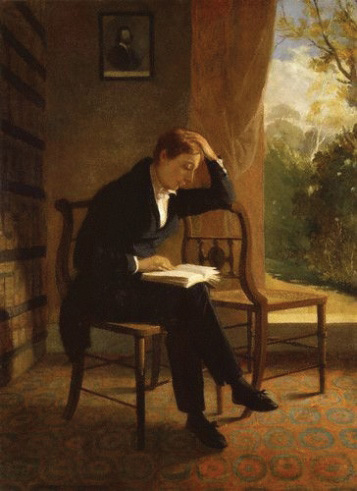
Portrait by Joseph Severn from Letters of John Keats to His Family and Friends.
ed. Sidney Colvin. Macmillan and Co., Limited. St. Martin's Street, London, 1925
Keats became acquainted with other writers such as Shelley and literary figures such as Leigh Hunt, in whose journal Keats published his first poem. Keats's early work was not well received. Several of Keats's friends, in fact, blamed discouragement caused by the harsh criticism for hastening the poet's death.
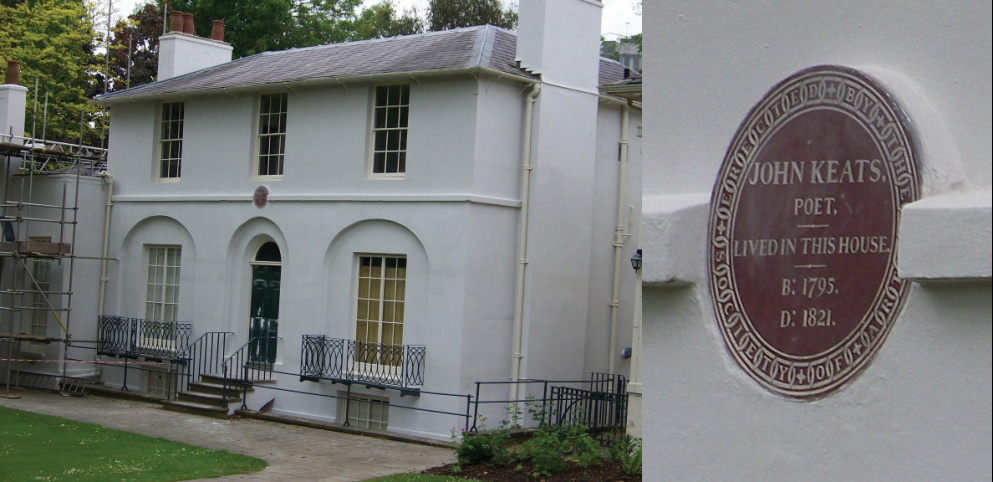
After his brother's death and with his own health deteriorating, Keats moved into a house in Hampstead with his friend Brown. Through Brown, Keats met Fanny Brawne, the love of his life. The Brawne family rented the attached house next door to Brown's house.
During the year he lived here, Keats produced his greatest poetry including "The Eve of St. Agnes," "Ode to Psyche," "La Belle Dame sans Merci," "Ode to a Nightingale," "Ode on a Grecian Urn," "Ode on Melancholy," "Lamia," The Fall of Hyperion, and "To Autumn." Many critics have noted that Keats produced more great poetry in a year than many poets produce in a lifetime.
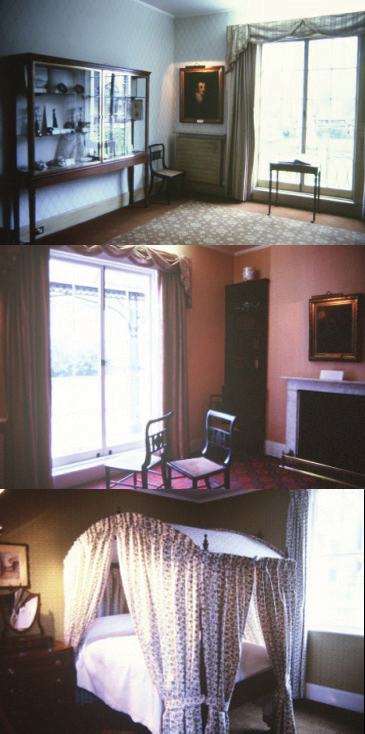
Views of the interior of Keats's house in Hampstead, London, now a museum.
Realizing that his health was failing, Keats decided to move to Rome, hoping that the warmer, drier climate would improve his condition. He traveled to Rome with his friend, artist Joseph Severn. They moved into rooms next to the Spanish Steps, rooms which now house the Keats-Shelley House museum.
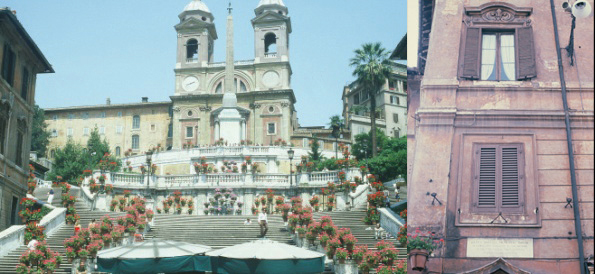
Only a few months after his arrival in Rome, Keats died with his friend Severn in attendance and was buried in the Protestant Cemetery in Rome. At his request, his name was not carved into his grave stone. Keats requested that his marker read, "Here lies one whose name was writ in water." Severn, who was later buried next to Keats, and Brown decided to add the following inscription to the memorial:
This Grave contains all that was mortal, of a YOUNG ENGLISH POET, who on his Death Bed, in the Bitterness of his heart, at the Malicious Power of his enemies, desired these words to be Engraven on his Tomb Stone
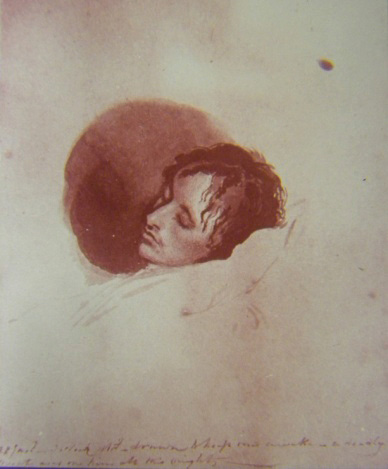
Severn's drawing of Keats on his death bed.
These words fueled stories that Keats's death was hastened by his despair over the brutal critical reviews of his poetry. Shelley's elegy Adonais includes verses attributing Keats's death to his agitation over the reviews, also adding substance to the stories. A post-mortem, however, revealed that Keats's lungs had been almost entirely destroyed by tuberculosis.
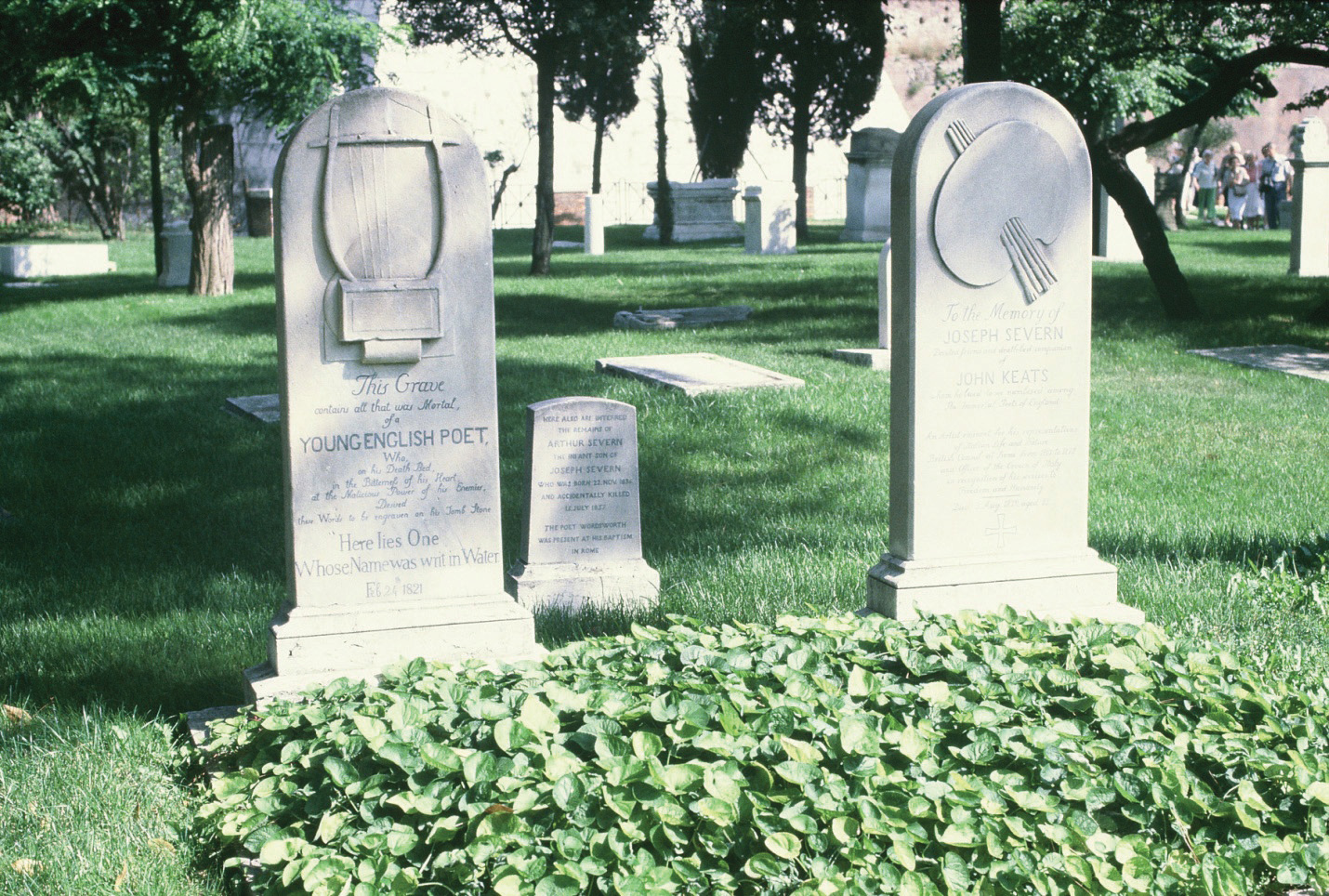
The graves of Keats and Severn in the Protestant Cemetery in Rome.
"On Seeing the Elgin Marbles"
Even as a very young man, Keats seemed tragically aware of death and of his own mortality, as might be expected in one who had suffered loss of immediate family members. Although the subject of this sonnet is the Elgin Marbles, the focus in the first line is on approaching death. In line 5, the poet compares himself to a sick eagle, looking at the sky, longing to fly, yet unable to do so. In contrast to his own brief life span, the marbles are centuries old, yet even they are marked and worn by time.
Video Clip 9
John Keats.wmv
(click to see video)
View a video mini-lecture about "On Seeing the Elgin Marbles."
My spirit is too weak—mortality Weighs heavily on me like unwilling sleep, And each imagined pinnacle and steep Of godlike hardship tells me I must die Like a sick eagle looking at the sky. Yet 'tis a gentle luxury to weep That I have not the cloudy winds to keep Fresh for the opening of the morning's eye. Such dim-conceived glories of the brain Bring round the heart an undescribable feud; So do these wonders a most dizzy pain, That mingles Grecian grandeur with the rude Wasting of old time—with a billowy main— A sun—a shadow of a magnitude. My spirit is too weak—mortality Weighs heavily on me like unwilling sleep, And each imagined pinnacle and steep Of godlike hardship tells me I must die Like a sick eagle looking at the sky. Yet 'tis a gentle luxury to weep That I have not the cloudy winds to keep Fresh for the opening of the morning's eye. Such dim-conceived glories of the brain Bring round the heart an undescribable feud; So do these wonders a most dizzy pain, That mingles Grecian grandeur with the rude Wasting of old time—with a billowy main— A sun—a shadow of a magnitude. My spirit is too weak—mortality Weighs heavily on me like unwilling sleep, And each imagined pinnacle and steep Of godlike hardship tells me I must die Like a sick eagle looking at the sky. Yet 'tis a gentle luxury to weep, That I have not the cloudy winds to keep, Fresh for the opening of the morning's eye. Such dim-conceived glories of the brain Bring round the heart an indescribable feud; So do these wonders a most dizzy pain, That mingles Grecian grandeur with the rude Wasting of old Time—with a billowy main— A sun—a shadow of a magnitude.
"When I Have Fears That I May Cease to Be"
"When I Have Fears That I May Cease to Be" is an English sonnet; Keats was more interested in form than many of the Romantic poets, which in turn made him interesting to many Victorian poets who experimented with form. The sonnet consists of three quatrains, each beginning with "when," and a final couplet, which begins with "then."
When I have fears that I may cease to be Before my pen has glean'd my teeming brain, Before high piled books, in charact'ry, Hold like rich garners the full-ripen'd grain; When I behold, upon the night's starr'd face, Huge cloudy symbols of a high romance, And think that I may never live to trace Their shadows, with the magic hand of chance; And when I feel, fair creature of an hour! That I shall never look upon thee more, Never have relish in the faery power Of unreflecting love!—then on the shore Of the wide world I stand alone, and think Till Love and Fame to nothingness do sink.
"The Eve of St. Agnes"
"The Eve of St. Agnes" is a narrative poemA poem that tells a story. , a poem that tells a story. It is also an example of the medieval revivalThe renewed interest in the Middle Ages evident in some Romantic literature. , the renewed interest in the Middle Ages evident in some Romantic literature. During the 19th century, many writers idealized the Middle Ages; it seemed romantic and less complicated than the modern world. However, they often had a fairy tale view of medieval times, thinking only of knights in shining armor rescuing fair damsels in distress rather than recognizing the harsh, violent time period that it really was.
This story is set in the Middle Ages and is a type of Romeo and Juliet story of two feuding families and the children who love each other in spite of their families' enmity. Ambiguity at the end of the story leaves readers to decide whether Madeline and Porphyro "live happily ever after" or whether they freeze in the winter night.
Central to the story is a medieval superstition concerning St. Agnes Eve. This type of superstition—a ritual that allows young girls to find out who their future husband will be—is common in many cultures. In America's past there have been superstitions and folklore involving sleeping with a piece of wedding cake under your pillow, or peeling an apple and throwing the peel over your shoulder. In the Middle Ages, superstition specified a ritual which, if followed on St. Agnes Eve, would allow a girl to dream of her future husband. Note the specifics of the ritual in Stanza 6. Porphyro, aided by Madeline's nurse, decides to take advantage of his knowledge that his beloved Madeline will be expecting to see a vision of her true love. Note in Stanza 35, however, how Madeline reacts to the real Porphyro compared with her dream.
"The Eve of St. Agnes" presents the reader with two contrasting worlds, separated by symbolic doors. The poem begins with a description of a harsh, cold landscape in which even nature suffers, focusing on the beadsman, near freezing to death, who prays for the family. A door opens, and the reader is ushered into a warm, colorful world inside the house where the main action takes place. Then in Stanza 41, a door opens again and the lovers leave the castle, taking with them any hint of love and warmth. The poem ends in images of death and cold.
"To Autumn"
SEASON of mists and mellow fruitfulness, Close bosom-friend of the maturing sun; Conspiring with him how to load and bless With fruit the vines that round the thatch-eves run; To bend with apples the moss'd cottage-trees, And fill all fruit with ripeness to the core; To swell the gourd, and plump the hazel shells With a sweet kernel; to set budding more, And still more, later flowers for the bees, Until they think warm days will never cease, For Summer has o'er-brimm'd their clammy cells.
2
Who hath not seen thee oft amid thy store? Sometimes whoever seeks abroad may find Thee sitting careless on a granary floor, Thy hair soft-lifted by the winnowing wind; Or on a half-reap'd furrow sound asleep, Drows'd with the fume of poppies, while thy hook Spares the next swath and all its twined flowers: And sometimes like a gleaner thou dost keep Steady thy laden head across a brook; Or by a cyder-press, with patient look, Thou watchest the last oozings hours by hours.
3
Where are the songs of Spring? Ay, where are they? Think not of them, thou hast thy music too,— While barred clouds bloom the soft-dying day, And touch the stubble plains with rosy hue; Then in a wailful choir the small gnats mourn Among the river sallows, borne aloft Or sinking as the light wind lives or dies; And full-grown lambs loud bleat from hilly bourn; Hedge-crickets sing; and now with treble soft The red-breast whistles from a garden-croft; And gathering swallows twitter in the skies.
"Ode to a Nightingale"
While Keats lived in Brown's Hampstead house, a plum tree grew next to the front door. One evening, Keats was sitting under the tree when he heard a nightingale singing from the tree.
The poem begins by focusing on the speaker, sick at heart and in spirit, envious of the bird's happiness. The speaker searches for a way to escape the pain of living. In Stanza 2 he considers wine as a means of escape but rejects that possibility.
In Stanza 3, the speaker recognizes that wine will not make him forget the "weariness, the fever, and the fret" of living, hardships that the nightingale has never known. Even in poetry, the speaker does not find an escape from the cares of living. So burdened by the pain of life, the speaker confesses that he has at times been "half in love with easeful death." He adds that this moment, enraptured by the beauty of the bird's song, seems an even more tempting time to die. He realizes, however, that in death he would miss the small consolation of this beauty.
In Stanza 7, the speaker exclaims, "Thou wast not born for death, immortal Bird!" He recognizes that since ancient times people have been enchanted by this same song.
Finally, he imagines the bird flying across the meadow and river, leaving the speaker wondering if he had imagined or dreamed the entire experience.
Key Takeaways
- More interested in poetic form than many Romantic writers, Keats wrote sonnets.
- Keats's "The Eve of St. Agnes" is an example of the medieval revival.
- Keats uses nature to express his themes, often themes concerning death.
Exercises
- What characteristics of Romanticism are evident in Keats's poetry?
- How does Romantic mysticism appear in the works of Keats?
- How does Keats's use of nature compare with that of other Romantic writers?
"When I Have Fears that I May Cease to Be"
- What does Keats mean when he writes, "When I have fears that I may cease to be"?
- The poet expresses a different fear in each quatrain. What are his three fears?
- His only consolation from his fears is expressed in the final couplet. What is it?
- Why does this poem seem especially sad when we know Keats's biography?
"The Eve of St. Agnes"
- Keats is known for the richness of the descriptive imagery in his poetry. Compile a chronological list of the scenes in the poem, and list some of the description included in each scene. (For example, the first scene in the poem is outdoors, with the owl, the rabbit, and the frozen grass.)
- "The Eve of St. Agnes" is a poem of contrasts. List and explain contrasting ideas you find in the poem (for example, youth and old age, warmth and cold).
- Write a character sketch of Madeline, including a physical description, character traits, and actions and motives in the poem.
- Write a character sketch of Porphyro, including a physical description, character traits, and actions and motives in the poem.
- What do you think happened to the lovers?
Resources
Biography
- "Afterlife." Presenting John Keats. Curated by Libby Chenault and Katherine Carlson, Rare Book Collection, Wilson Library. The University of North Carolina at Chapel Hill.
- John Keats 1795–1821. Keats-Shelley House. includes images of Romantic writers, manuscripts, first editions.
- John Keats (1795–1821). Online Gallery: John Keats. British Library. includes images of Keats and of manuscripts.
- "The Life and Legacy of John Keats." Presenting John Keats. Curated by Libby Chenault and Katherine Carlson, Rare Book Collection, Wilson Library. The University of North Carolina at Chapel Hill.
- "Work and Reappraisal." Presenting John Keats. Curated by Libby Chenault and Katherine Carlson, Rare Book Collection, Wilson Library. The University of North Carolina at Chapel Hill.
Text Image
- "The Eve of St. Agnes: a Poem / by John Keats; With a Preface Written for It by Edmund Gosse. Edition limited to 800 copies made upon L.L. Brown's H.M. paper…printed…from plates made from drawings for each page, designed & lettered by Ralph Fletcher Seymour. Hathi Trust Digital Library.
What Aspect Of Romantic Writing Did Realist Writers Disapprove Of?
Source: https://2012books.lardbucket.org/books/british-literature-through-history/s06-the-romantic-period.html
Posted by: burkeawking.blogspot.com

0 Response to "What Aspect Of Romantic Writing Did Realist Writers Disapprove Of?"
Post a Comment